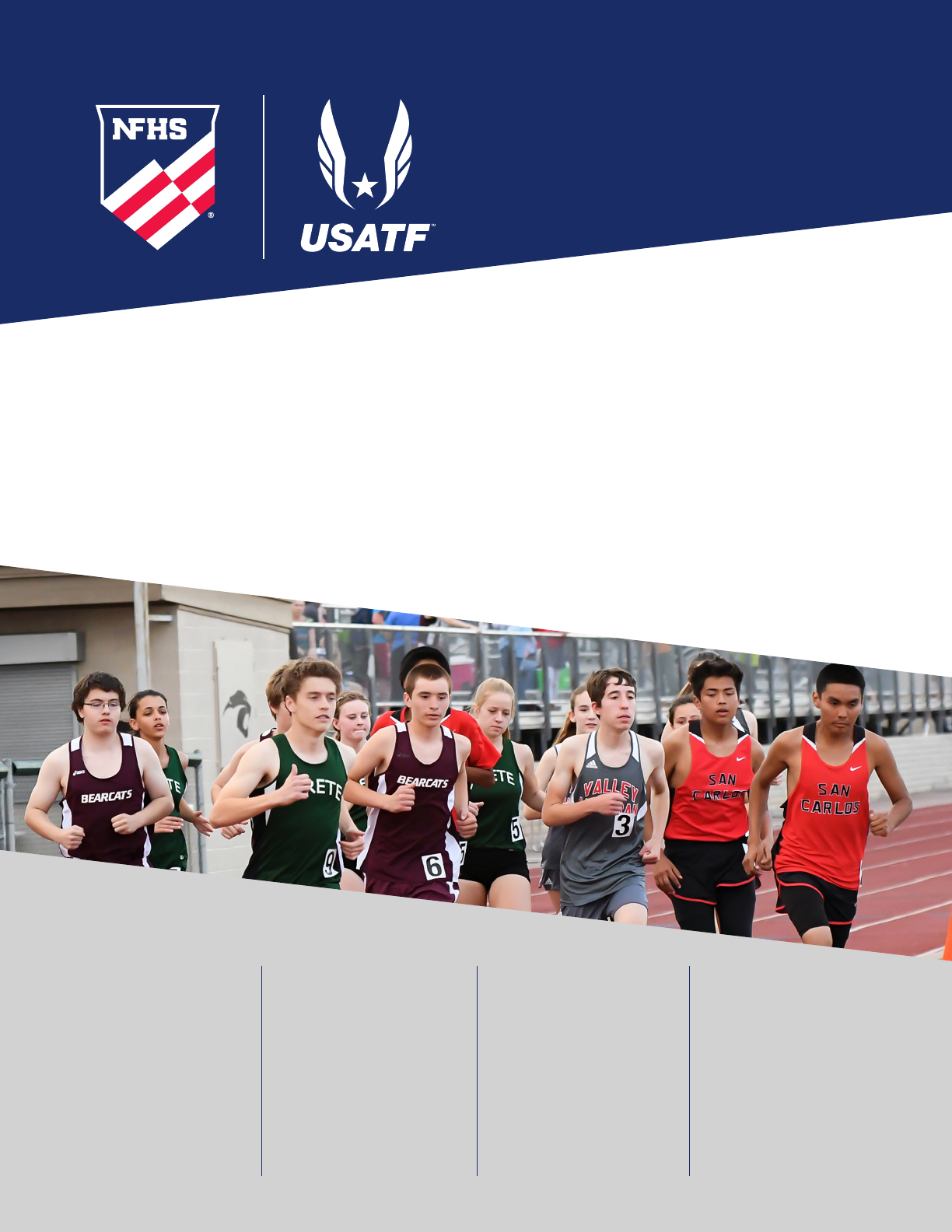
TRACK AND FIELD
PRE-MEET NOTES
01 HIGHLIGHTS OF RULES CHANGES
01
Rerun Guidelines:
Moved and dened
specic guidelines from
the case book to oer
consistency and guidance
to a meet referee when
ruling on reruns.
02
Hold Times for Starters:
Standardize starter hold
times for fair and consistent
starts.
03
Relay Entry Increase:
Gives opportunity for
more athletes to be
involved in regular and
postseason track meets.
04
New Indoor Track and
Field Rule:
Creates an indoor specic
rules section.
2023
Photo provided by Paynter Pics, Arizona Interscholastic Association.
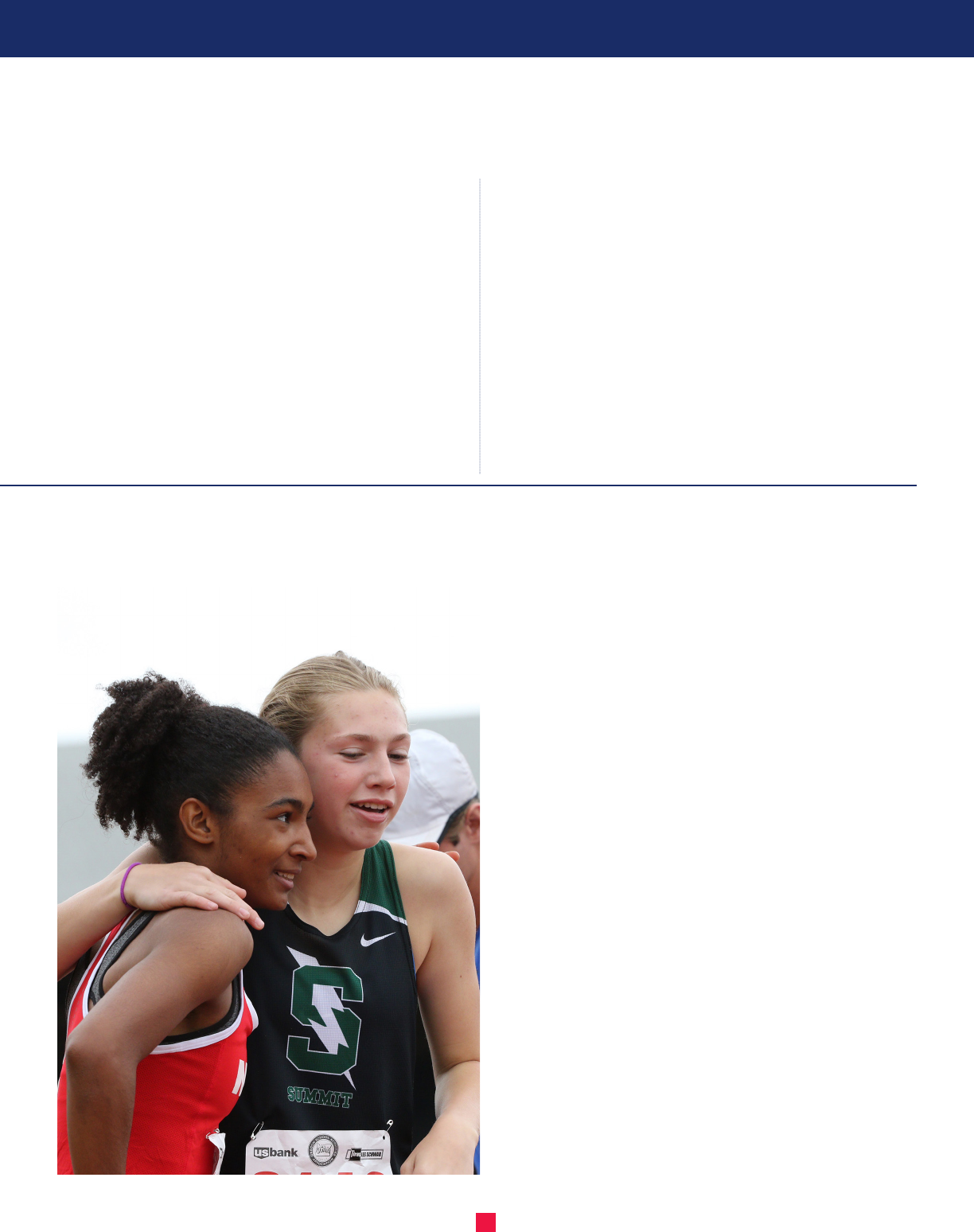
2
2023 PRE-MEET NOTES
IN THIS ISSUE:
01 RULES CHANGES HIGHLIGHTS
02 2022 POINTS OF EMPHASIS
03 JUDGING LANE VIOLATIONS ON THE CURVE
04 RESOLVING TIES IN FIELD EVENTS
05 THE USE OF ELECTRONIC DEVICES IN RUNNING AND
FIELD EVENTS
06 ADMINISTERING RELAY EXCHANGES FOR RACES NOT
RUN IN LANES
07 HOW TO UTILIZE A WIND GAUGE IN RUNNING AND
FIELD EVENTS
08 EFFECTIVE IMPLEMENT INSPECTION – SHOT PUT
& DISCUS
09 BENEFITS OF WEIGHING POLE VAULTERS ON SITE
PRIOR TO COMPETITION
10 TRACK AND FIELD INJURY SURVEILLANCE STUDY
11 GUIDANCE FOR THE ADMINISTRATION OF
RERUNNING RACES
12 MIXED RELAYS AT TRACK & FIELD MEETS
13 CORRECTLY MEASURING JAVELIN THROWS
14 FAIR & CONSISTENT STARTS
15 MENTORSHIP AS AN OFFICIATING RETENTION
STRATEGY – DANA M. PAPPAS, NFHS DIRECTOR
OF OFFICIATING SERVICES
16 THE MEET DIRECTOR/FAT PROVIDER RELATIONSHIP
17 AN HONEST PERSPECTIVE: THROUGH THE LENS OF
AN EDUCATOR AND COACH
18 TIPS FOR SAFER RUNNING ALONG THE ROADSIDE
02
POINTS OF EMPHASIS
Sportsmanship
Good sporting behavior is one of the fundamental
ingredients to the continued success and enjoyment of
education-based high school sports and activities. In fact,
in the 103-year history of organized high school sports in the
United States, good sportsmanship has been one of the most
important outcomes of high school activity programs.
NFHS playing rules are written to encourage sportsmanship.
Participation in these programs should promote respect,
integrity and sportsmanship. However, for these ideals to
occur, everyone involved in these programs must be doing
their part.
The NFHS is concerned that unsporting behavior in
education-based athletics has increased across all sports. As
a result, the NFHS has made sportsmanship the No. 1 Point of
Emphasis for the 2022-23 school year.
Sportsmanship, or good sporting behavior, is about treating
one another with respect and exhibiting appropriate behavior.
It is about being fair, honest and caring. When these types
of appropriate behavior occur, competitive play is more
enjoyable for everyone.
Coaches set the tone at athletic contests with their display
Photo provided by Northwest Sports Photography, Beaverton, Oregon.

3
2023 PRE-MEET NOTES
of sportsmanship. If these individuals act in a sportsmanlike
manner, their behavior sets the tone for players, spectators
and others. If coaches, however, are complaining constantly
about the decision of contest ocials, spectators are more
likely to do the same.
There must be a collaborative, working relationship between
contest ocials and game administration to promote good
sportsmanship and safely conduct the contest. Everyone has
their roles to play in creating a positive, sportsmanlike
atmosphere at contests.
Ocials should focus on the actions of players, coaches
and other bench/sideline personnel. A positive, open line
of communication between ocials and coaches ultimately
results in a better contest for everyone involved.
Contest ocials, however, should never engage with
spectators who are exhibiting unsporting behavior. Once
the contest begins, school administration is responsible for
dealing with unruly spectators. A proactive approach by
school administration includes monitoring the behavior of
spectators and intervening as needed.
If spectators are using demeaning or profane language at
ocials – or at others in the stands – those individuals should
be removed from the contest by school administration.
In recent years, a heightened level of unsportsmanlike
behavior has been occurring by spectators at high school
sporting events, and it must be stopped. The use of
demeaning language, or hate speech, by students, parents
and other fans must cease.
High school sports and other activities exist to lift people
up, not demean or tear people down. The goal is to treat
everyone fairly and treat each other with respect. Any speech
or harassment that is insulting, demeaning or hurtful will not
be tolerated.
High schools must establish a culture that values the worth of
every single person – both players on the school’s team and
players on the opposing team. There must be a no-tolerance
policy regarding behavior that shows disrespect for another
individual.
Good sports win with humility, lose with grace and do both
with dignity. It takes the eorts of everyone every day to
ensure that sportsmanship remains one of the top priorities
in education-based activity programs.
Protest/Appeal Process
During a track and eld competition there are instances
where there are disagreements with an ocial’s call. In these
cases, a protest may be made to the Meet Referee. The Meet
Referee’s decision in all matters is nal. At meets where a Jury
of Appeals is appointed by the games committee a coach
may protest if they believe that the state’s terms and
conditions of competition or the application of the rule(s)
have been misapplied or misinterpreted by the Referee, a
written appeal may be made to the Jury of Appeals.
Video replay or television monitoring equipment, other
than the ocial nish line equipment approved by the games
committee prior to the start of competition, shall not be used
to make decisions related to the meet.
Coaches may NOT protest
a. Any judgment decision pertaining to violations or
alleged violations of the rules.
b. A decision made by the nish judges or timers that
does not involve misapplication of a rule, or the terms
and conditions of competition.
c. Whether a start is fair and legal.
Situations which are subject to protest/appeal include:
a. Misapplication of the rules which must be led within
30 minutes after the announcement of event results.
b. Correction of clerical or team scoring errors which may
be corrected up to 48 hours after the end of the meet,
unless another time period is specied in advance by
the games committee or meet director.
c. Correction of meet results involving an ineligible
participant which may be made at any time when
discovered.
d. Failure to follow a procedure contained in the terms
and conditions of competition announced in advance
by the meet director or games committee. This would
include such items as the time schedule, the number
of qualiers to advance, number of trials, etc.
Cross Country Safety
Training for Cross Country is unique in that there are so
many options aorded to the runner(s) to accomplish their
workouts. Not being limited to the track allows the runners
access to parks, city streets, highways and country roads.
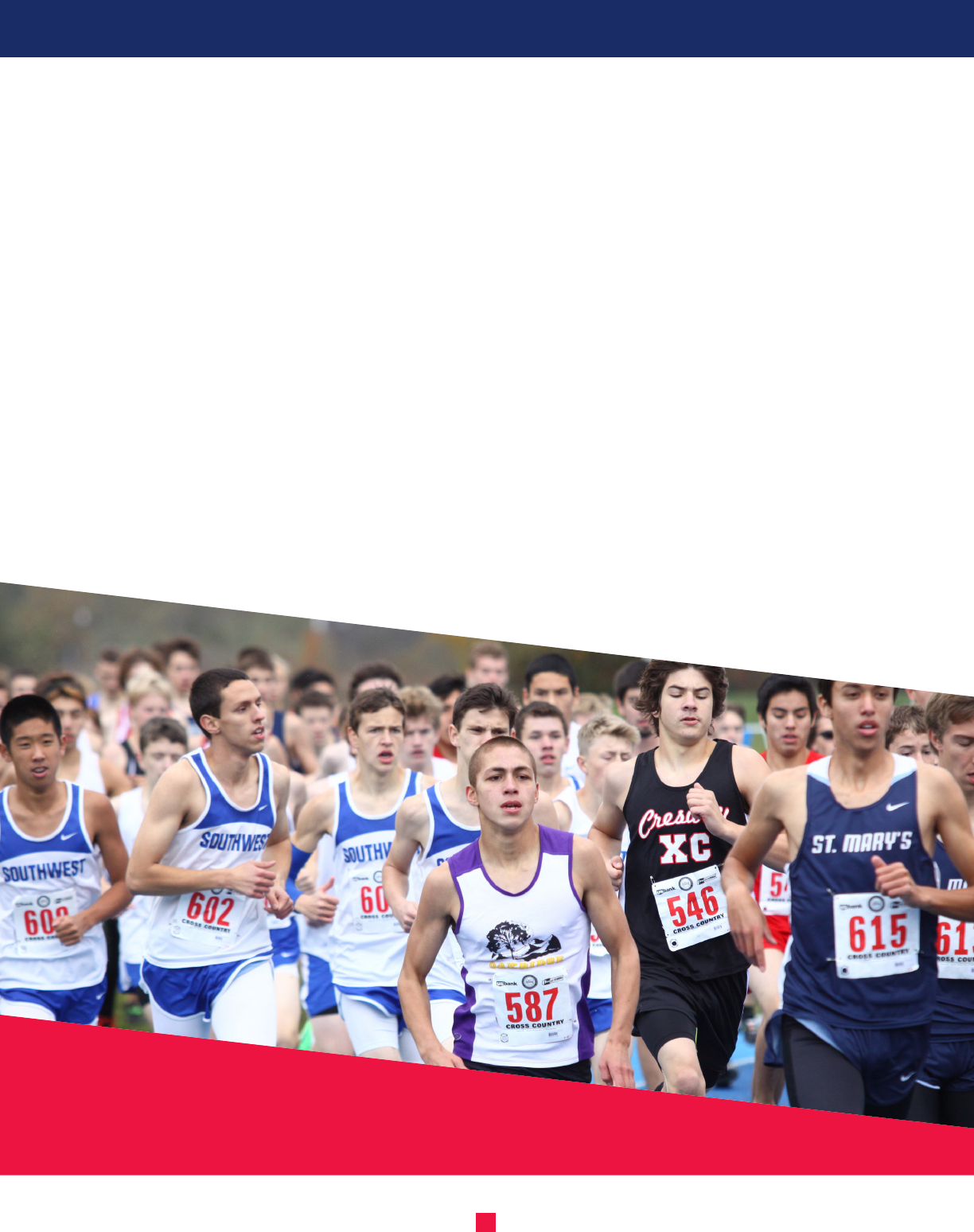
4
2023 PRE-MEET NOTES
However, each of these options creates safety concerns that
all runners and coaches should keep in mind. Workouts and
runs should be fun, relaxing, carefree experiences. Sadly,
the need for runner safety tips is evidenced by a dramatic
increase in pedestrian deaths in the United States, as well
as eight reported running-related motor vehicle crashes
resulting in nine deaths and two disabling injuries among
middle school and high school cross country and track and
eld runners between 2011 and 2021.
It is critical that administrators, coaches and athletes promote
and practice safety and risk minimization strategies as Cross
Country runners share the road with vehicles and drivers that
have become increasingly distracted on the roads. Some key
safety measures that can be promoted by school coaches and
others to their Cross Country runners include:
• Using sidewalks when available or run facing trac.
• Stay alert and avoid wearing headphones and using
electronic devices, including cell phones.
• Crossing roads at crosswalks and intersections, when
available. If not, cross at a well-lit location.
• Avoid running when it is dark. If it is dark, wear bright,
reective materials and/or use a ashlight or head lamp.
• Follow the rules of the road.
• Avoid running along eastbound roads at sunrise or along
westbound roads at sunset.
• Provide a safety orientation for rst-year runners
• Run in pairs
• Never run against trac lights
• Avoid running in higher trac speed areas
• Run during lower trac times if running along a road
• Avoid loitering along the road before and after runs
Coaches need to plan when developing a road route where
stop lights, routes, and heavy trac exist. Educating the
athletes on where to go for safety in case of weather,
emergency situations and hydration stops is crucial to athlete
safety.
Photo provided by Northwest Sports Photography, Beaverton, Oregon.
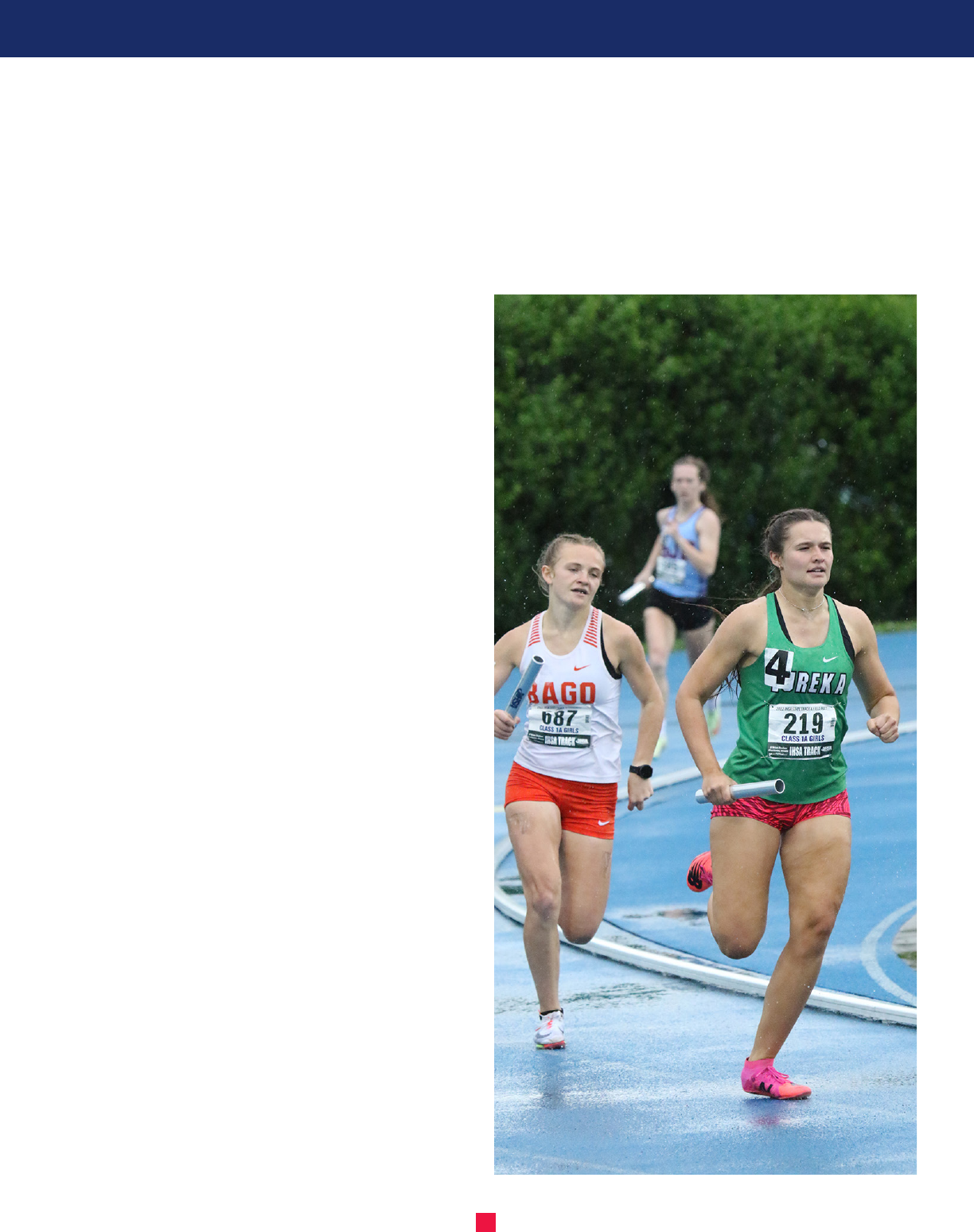
5
2023 PRE-MEET NOTES
Meet ocials or umpires observe each running event to
ensure that no competitor gains an advantage and no
competitor is placed at a disadvantage. This is most
important during races that are run around one or more
curves.
Situation 1
While running around the curve, a competitor steps on or
over the lane line to the left with multiple steps. Rule 5-12-1a:
Without being fouled and while running around a curve,
steps on or over the inside lane line or curb for three or
more consecutive steps with either or both feet.
As a meet ocial or umpire observing the race on a curve,
place yourself in a position to have the greatest visual vantage
point of all lanes. Observe the runners as they are approach-
ing you or having passed you and scan back and forth at their
feet. Pause at any runner whose feet are near the inside lane
line and observe attentively.
Situation 2
A less common lane violation on the curve involves
interfering with a runner assigned to the lane to the runner’s
right. This would occur most often in long hurdle races and
relays. Rule 5-12-1c:
While running around a curve, runs over the outside lane
line and interferes with another competitor.
Situation 3
A competitor shortens the running distance by cutting early
at the break line. Rule 5-12-1e:
The competitor takes one or more steps inside the assigned
lane line at the break line.
In these situations, as a meet ocial or umpire, it is important
to note what happened:
1. prior to the violation
2. during the violation
3. after the violation
4. how many steps over the line
5. approximately where the violation occurred
These are all vital aspects for the referee to be aware of,
to assist in making a nal determination of the situation.
In addition, it also provides the referee the necessary
information to explain to coaches, if a violation and
disqualication is warranted. Sample violation report forms
and infraction reporting forms may be found in the NFHS
Track and Field Ocials Manual Additional Forms section.
03
JUDGING LANE VIOLATIONS ON THE CURVE
Photo provided by Visual Image Photography, Illinois.

6
2023 PRE-MEET NOTES
Document reprinted from USATF Best Practices
If two or more competitors have the same best mark, the
procedure to decide places is as follows:
Vertical Jumps
First tie-breaker – among tied athletes, the one with the
fewest number of trials at the tied height is awarded the
higher place.
Second tie-breaker – if still tied, the athlete with the fewest
total number of unsuccessful trials up to and including the
tied height is awarded the higher place. Passes trials do not
count as a miss.
Third tie-breaker – if still tied; then:
For other than 1st place: Athletes remain tied (there is
no jump-o)
For 1st place: Conduct a jump-o per Rule 6-3-2b(4a)
Sample situation and event sheet
On the sample sheet below, only Crane has the best height of
3.80 meters, so she is awarded 1st place.
• Now we have to break a tie among three athletes
at the next best height of 3.70 meters. Adams and
Graham have zero misses at the tied height and Ed-
wards has one, so Adams and Graham go to the next
tie-breaker to determine places. Since Graham has
fewer total misses in the competition (0) than Adams
(1), Graham is awarded 2nd place and Adams is award-
ed 3rd place; Edwards is awarded 4th place.
• Four athletes have a best height of 3.60 meters.
Bradley, Howe, and Irons have one miss at the tied
height, so we must go to the next tie-breaker to
determine their places. Bradley has fewer total misses
in the competition (2) so she is awarded 5th place;
Howe and Irons have the same number of overall
misses, so they remain tied for 6th place; and Jackson
(with two misses at the tied height) is awarded 8th
place.
In the sample event sheet below, the next-to-last column
provides a way to record the number of trials (attempts)
at the tied height (first number) and the total number of
misses throughout the competition (second number).
04
RESOLVING TIES IN FIELD EVENTS
1 Adams – – – X O – – – O X X X 3.70 1 /1 3
2
Bradley O X O X O – X X X 3.60 2 / 2 5
3
Crane – – – – – – – – – X X O X O X X X 3.80 2 / 3 1
4
Douglas X X X NM – –
5
Edwards – – – – – – O X O X X X 3.70 2 / 1 4
6
Graham O O O O X X X 3.70 1 / 0 2
7
Howe X O X X O X O X X X 3.60 2 / 4 6 Tie
8
Irons X X O X O X O X X X 3.60 2 / 4 6 Tie
9
Jackson O X O X X O X X X 3.60 3 / 3 8
Imper.
Name 3.30 3.45 3.60 3.70 3.80 3.90
Bib
#
Metric
BEST
MARK
Jumps
Tied Ht
Total
Misses
PLACE
Sample Event Sheet
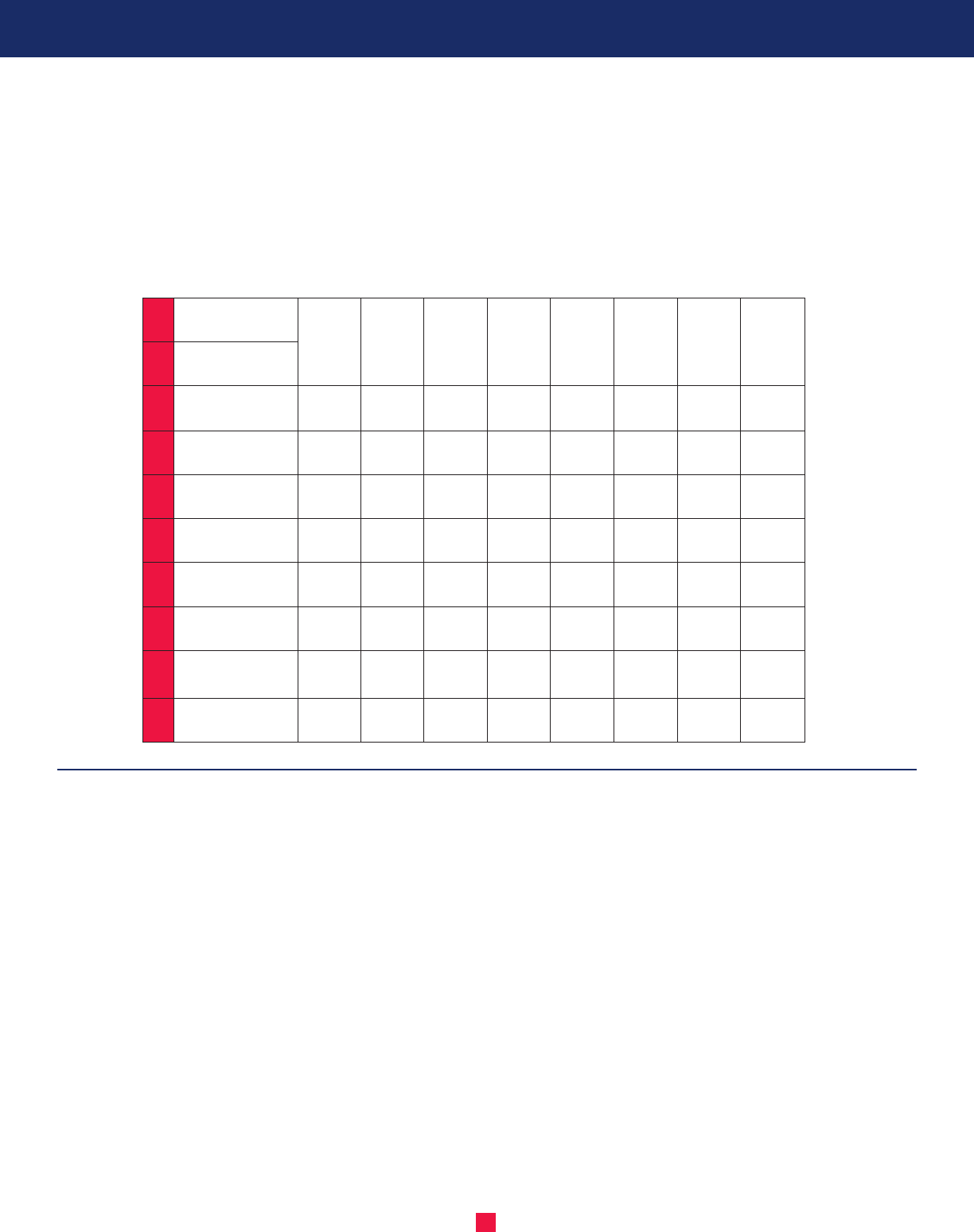
7
2023 PRE-MEET NOTES
Horizontal Jumps & Throws
First tie-breaker – among tied athletes, the one with the
greater 2nd best distance is awarded the higher place.
Second tie-breaker – if still tied, the athlete with the greater
3rd best distance is awarded the higher place; if still tied,
repeat this process, using the 4th best distances and if
necessary, then the 5th and 6th best distances.
Sample situation and event sheet
On the sample sheet below, each athlete’s best throw is
circled. Davis clearly has the best throw in the competition and
is awarded 1st place. The next best distance is 20.85 meters by
both Frawley and Hu, so you then compare their second-best
throws, and since Hu’s 20.60 is better than Frawley’s 20.32,
Hu is awarded 2nd place and Frawley 3rd place.
05
THE USE OF ELECTRONIC DEVICES IN
RUNNING AND FIELD EVENTS
The role of electronic devices in the daily lives of most
people is central and growing. In some places, large
majorities of people no longer have a “land” telephone,
and instant communication is an expectation. Many
teachers incorporate a student’s use of a cell phone into the
daily lesson plan. These developments make a Track & Field
meet one of the few locations where technology used for
communication between coaches and athletes remains
prohibited in most situations.
The NFHS rules specically address electronic devices,
empowering the Games Committee to establish the
boundaries of restricted and unrestricted areas (Rule 3-2-4g).
Electronic devices may be used in unrestricted areas, as
long as that use does not interfere with the progress of the
meet (Rule 3-2-8). However, the use of any device during
competition is forbidden and results in the disqualication
of the competitor (Rule 3-2-8a). To avoid confusion, the
restricted and unrestricted areas must be dened by meet
management prior to the start of every meet.
Today, an increasing number of competitors use “wearable
technology” in the form of smartwatches. Some of the
devices made by Fitbit, Apple, Samsung, and others
Name
Bib
#
BEST
DIST.
PLACE
Sample Situation and Event Sheet
Aliation
1st
Att.
2nd
Att.
3rd
Att.
4th
Att.
5th
Att.
6th
Att.
1 Jack Adams 18.19 X 19.05 19.17 X 18.91 19.17 4
2 James Burroughs 17.50 X X – – – 17.50 6
3 Bill Campbell 18.64 X X X 18.62 18.87 18.87 5
4 Rod Davis 19.98 X 20.93 21.13 20.97 X 21.13 1
5 Nick Edwards 16.46 16.66 17.17 – – – 17.17 8
6 Adam Frawley 20.32 19.95 X X 20.85 X 20.85 3
7 Brent Grant 17.17 17.20 17.43 X X 17.06 17.43 7
8 Charlie Hu X 19.12 19.04 20.85 20.60 X 20.85 2
#

8
2023 PRE-MEET NOTES
function as watches – which the rules allow (Rule 4-6-5 NOTE
2). However, these devices can also receive text messages or
phone calls. If that occurs in a restricted area (or during actual
competition), the receiving of electronic communications vio-
lates the rules. Preventative ociating is the key to managing
wearable technology in the eld of play.
Possible approaches include:
1. Reminding those at the pre-meet coaches’ meeting
where the boundaries of coaches’ boxes and other
unrestricted areas are located that allow electronic
devices to be used;
2. Training ocials to be aware of the newer technologies
and be observant of possible violations of the rules;
3. A meet could exclude any “wearable technology” from
restricted areas if announced in a meet’s published
information; and
4. A state association could take action by limiting the
denition of a watch, excluding any devices that can
receive information from an outside source.
Let’s review some track & eld situations involving
technology:
A. At the pole vault, a coach observes the athletes from
the designated coaching box near the pit on the
ineld. The coach may show a video of the attempt
to the athlete after the attempt is complete at the
coaching box; a permitted action because both the
coach and the athlete are in an unrestricted area.
B. At an invitational meet, the high jump is held on the
ineld, but no coaches’ box is available inside the
track. However, the Games Committee sets aside
an area outside the track, but inside the fence,
designating it an unrestricted area. Athletes can enter
this area and view videos over the fence without worry.
[In the case of consecutive jumps, the time to view video may
be limited since video review may not occur once the athlete’s
trial begins and the athlete goes, “on the clock.”]
C. While waiting for an implement to be returned during
the warm-up period, an ocial at the discus cage
hears a buzz and looks around. The next time the
ocial hears it, the ocial observes a student-athlete
staring at their watch and tapping the screen. Before
the competition begins, the ocial reminds all com-
petitors about the rules governing electronics, and
that a smartwatch’s communications ability violates
the rules. After the brief meeting, three competitors
remove their devices.
D. During a height change at the pole vault, an o-
cial notices a vaulter sitting adjacent to the runway,
wearing what appear to be wireless earbuds. As the
ocial gets nearer, the ocial gestures to their ears
and the student-athlete removes them. The ocial
can hear music playing from the device and summons
the referee. After conrming the situation, the referee
disqualies the competitor from the event for using an
electronic device in a restricted area.
Technology is constantly changing and evolving and the
need for ocials to be aware of innovations is critical to
maintaining fair and equitable competition within the
rules. Disqualication from an event is a steep price for a
competitor to pay for using technology without thinking
of the consequences rst.
Remember:
1. Athletes may view video of eld event attempts while
in unrestricted areas and not “on the clock.” The
athlete and the coach must both be in an unrestricted
area.
2. Competitors may not use an electronic device in a
restricted area at any time.
3. Coaches may not use any electronic device to
communicate with an athlete during a track event.
Disqualication from an event is a steep price for a
student-athlete to pay for using technology without
thinking rst.
Note: Be sure to check with your state high school association
for adaptions that your state may have in place regarding
electronics and wearable technology.
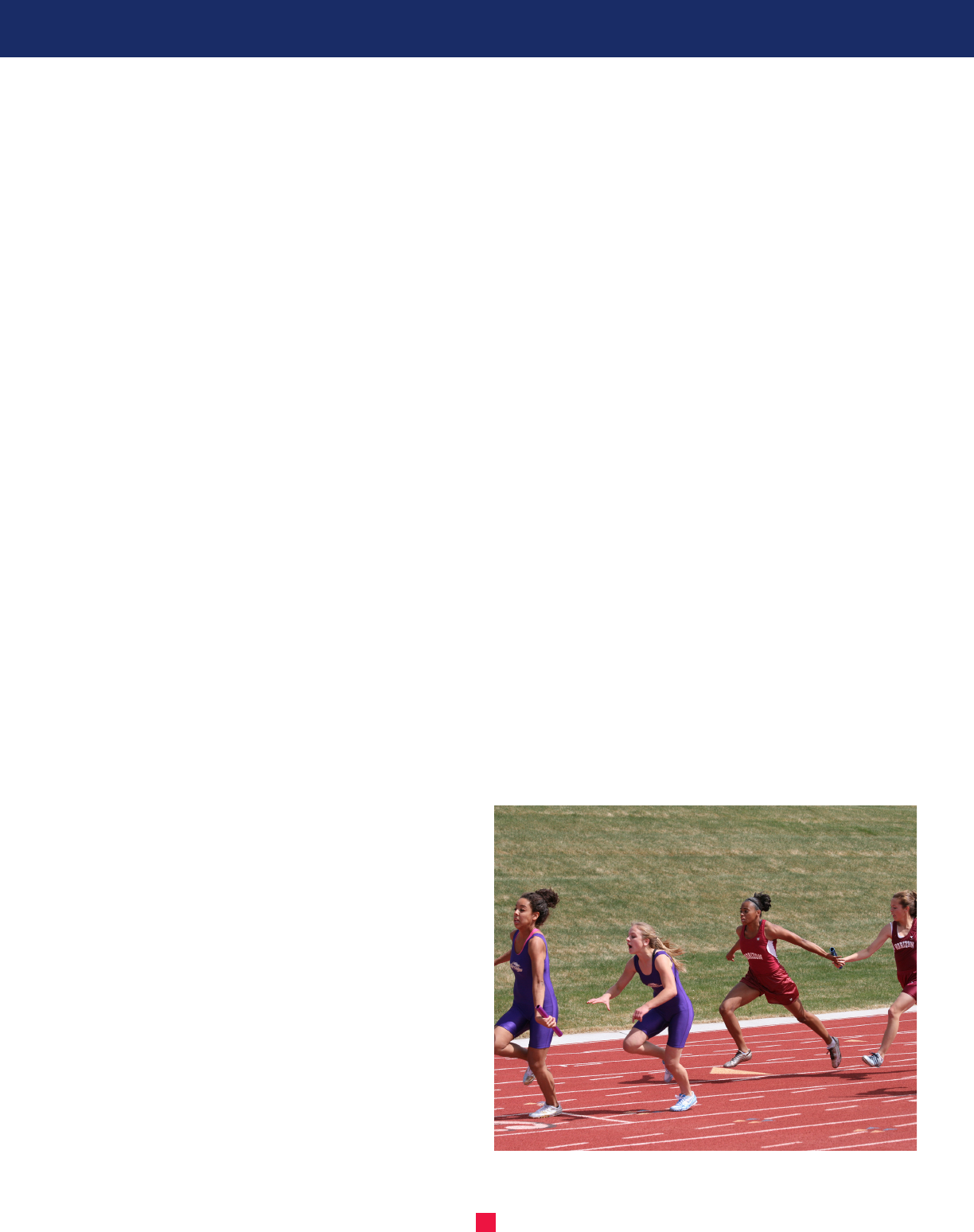
9
2023 PRE-MEET NOTES
Relays are an exciting part of track & eld meets. Some
relays (4x100m & 4x200m) are run entirely in each team’s
assigned lanes. Other races (4x400m & 4x800m) are not run
completely in lanes and may require pre-race and during-the-
race administration. Good communication helps facilitate
the smooth, ecient, fair and consistent competition, while
minimizing the potential for problematic situations.
Pre-Race Communications
1. Assemble all the competitors who are not running in
lanes to the outside of the track.
a. A good location is before the start/nish line
so athletes don’t get too involved and possibly
interfere with earlier legs. Make sure your location
works for the ow of your meet.
2. Maintain them in groups by leg and brief each group.
3. Remind competitors of the following:
a. The lines or triangles and colors marking the start
and end of the zone.
b. There is no acceleration zone for legs where the
incoming runner is running more than 200m.
c. They must commence their run from a stationary
position within the exchange zone.
d. Check marks are not permitted.
e. Should they wander outside the zone, they must
return and be stationary, albeit briey, before the
exchange takes place.
f. The exchange must take place entirely within the
zone.
4. The outgoing competitor may not touch the baton
before the baton is inside the zone and must be in
sole possession of it before exiting the zone.
5. The athlete may retrieve a baton dropped inside the
zone but must not impede other competitors.
6. If the baton has rolled o the track, return to the
track at the point you left to avoid the possibility
of shortening the course.
7. After passing the baton, the relieved competitor
should stand still or jog straight ahead and step o the
track when clear. If in Lane 1, they can exit the track
onto the ineld immediately.
8. After all incoming runners have passed the baton and
the track is cleared, the runner/runners must exit the
track and proceed onto the ineld or other designated
area that the facility dictates.
If possible, this designated post exchange area should be
set up 10-15 meters away from the track area. This will keep
the incoming relay runner/runners from moving around the
ineld area and cut down on any potential safety hazards in
the ineld.
During The Race Communications
1. The assigned ocial should provisionally line
competitors up in starting lane order according to
the order of the incoming runner/runners.
2. Escort competitors to the front of the exchange zone
once the previous leg has been completed.
3. Remind the outgoing runner again where the front
of the zone is and ask any athlete not in the zone to
move forward.
4. Patrol the area before the zone, then get out of the
way and watch the exchange. Issue general reminders
if need be – be proactive, not reactive!
A limited timeframe does not always permit the
communication of necessary information at the event.
It is therefore incumbent upon coaches to educate
their team on the principles and policies of relays.
06
ADMINISTERING RELAY EXCHANGES FOR RACES
NOT RUN IN LANES
Photo provided by Pam Wagner, Colorado High School Activities Association.

10
2023 PRE-MEET NOTES
Pre-Meet Coaches Communications
To Their Teams
1. Competitors need to position themselves so that their
incoming runner can run in a straight line.
2. Competitors may move to a position better suited to
meet the incoming runner.
3. There is no point at which the order of athletes lining
up for the exchange is xed.
4. The outgoing runner is responsible for taking a
position that corresponds with where the passer
is entitled inside the zone.
5. The baton must be handed, not thrown from the
incoming runner to the outgoing runner.
6. If the baton is dropped within the exchange zone in
a legitimate attempt to pass the baton, either runner
may retrieve it, provided they do not interfere with an
opponent, and it is retrieved within the limits of the
exchange zone, extended across the track.
7. If the baton is dropped outside of the exchange zone
or rolls outside of the exchange zone, the baton must
be retrieved by the runner who dropped it.
Relays are an exciting part of track & eld meets. Proper
communication by the ocials on the event protocols and
expectations will give competitors a safe and fair competition,
allowing them to compete to their fullest potential.
07
HOW TO UTILIZE A WIND GAUGE IN RUNNING AND
FIELD EVENTS
During the outdoor track and eld season, the weather can
play a part in assisting an athlete or act as a hindrance in
their athletic eorts. All sorts of variations come into play at
track meets that can create a variety of outcomes, one being
the wind. Winds do not always blow at a steady rate. Winds
surge, subside and shift in direction with no prior knowledge.
As a result, wind can have a distinct impact on the
competition.
One area of common omission at the high school level is the
delinquency in the use of an anemometer (wind gauge) for
some running and eld events. Results should not only have
the times and distances noted but should also indicate the
one variable that can have an impact on the outcome of the
athlete’s endeavors.
Anemometers or wind gauges are used to measure the aver-
age velocity of the wind over a pre-determined period during
a race or during horizontal jumps. An assisting wind (as de-
scribed in Rule 10-2-1) is one that blows at the runner’s back,
either directly or in a slanting direction. The events in need of
a wind reading include the 100m, 200m, 100m/110m hurdles,
triple jump and long jump. The sole purpose of a wind gauge
reading is to ratify that the result of the eld event attempt
or race did not have any assisting wind over the prescribed 2
meters per second (4.474 mph). No matter how fast you run
or how far you jump, your results must be under the legal
limits outlined in the NFHS Track and Field Rules Book to be
considered for a record. The wind readings may also be used
for qualifying marks and seeding purposes for future meets.
The wind gauge is a calibrated wind instrument that uses a
directional tube, which measures a wind reading expressed
in meters per second (m/s) (Rule 10-2-2). Resultant times are
rounded and recorded to the next higher tenth of a m/s in
the positive direction (a reading of 3.03 m/s shall be record-
ed as 3.1 m/s). A positive reading means the wind direction
is from behind, while a negative reading references the wind
that blows against an athlete.
SPRINTS – Wind Gauge Setup and Positioning
1. Placed on inside of track 164 feet (50m) from
the nish line;
2. Positioned within 2 meters of the track; and
3. 4 feet (1.22 meters) above the competition surface.
The length of time for the anemometer to measure each race
is determined by the NFHS Track and Field Rules Book and is
an average of wind velocity for the duration of the prescribed
length of time.
SPRINTS – Measurement Times
1. 100m – 10 seconds (time commences at the discharge
of the starting device)
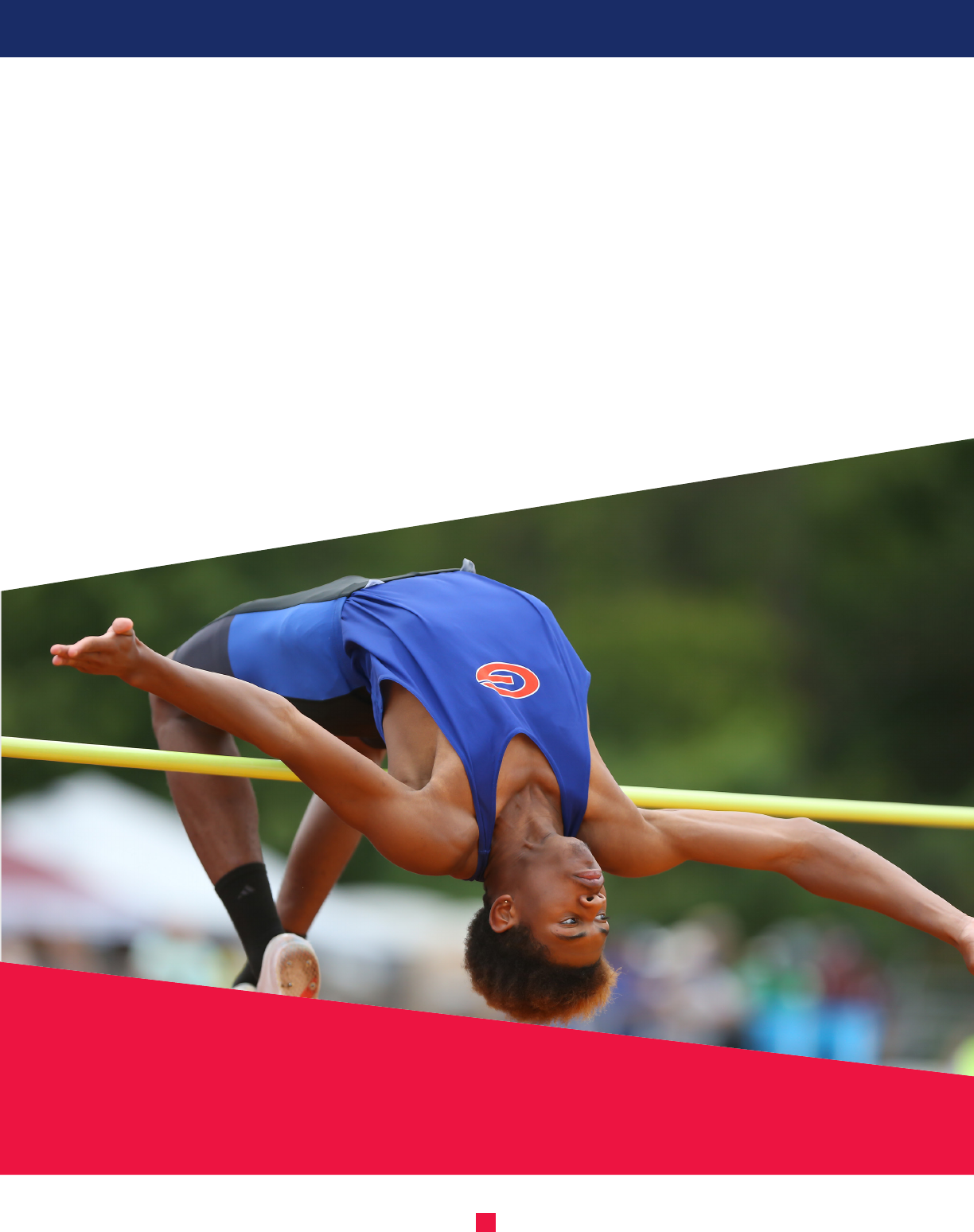
11
2023 PRE-MEET NOTES
2. 200m – 10 seconds (time commences when the lead run-
ner enters the straightaway)
3. 100m/110m hurdles – 13 seconds (time commences at
the discharge of the starting device)
You do not have to worry about when to start or stop the
anemometer because with today’s technology the gauge is
pre-set to automatically function at the correct time, selected
for the event.
HORIZONTAL JUMPS – Wind Gauge Setup
and Positioning
1. Placed 66 feet (20m) from the foul line;
2. Positioned within 2 meters of the runway; and
3. 4 feet (1.22 meters) above the competition surface
HORIZONTAL JUMPS – Measurement Times
1. Long Jump – 5 seconds
2. Triple Jump – 5 seconds
When multiple takeo boards are used, the 20-meter
mark will be set from the foul line furthest from the pit.
The measurement time commences when the competitor
initiates their trial.
All NFHS national record applications for 100m, 200m,
100m/110m hurdles, triple jump, and long jump require
anemometer readings. In addition, elite high school
competitors applying for national championships and
competitions should check to determine if the intended
competition requires the anemometer readings. For a record
to receive NFHS consideration, the performance shall also be
made at a sanctioned event involving ve or more schools
and limited to high school contestants who are representing
their high school.
Photo provided by Mississippi High School Activities Association.
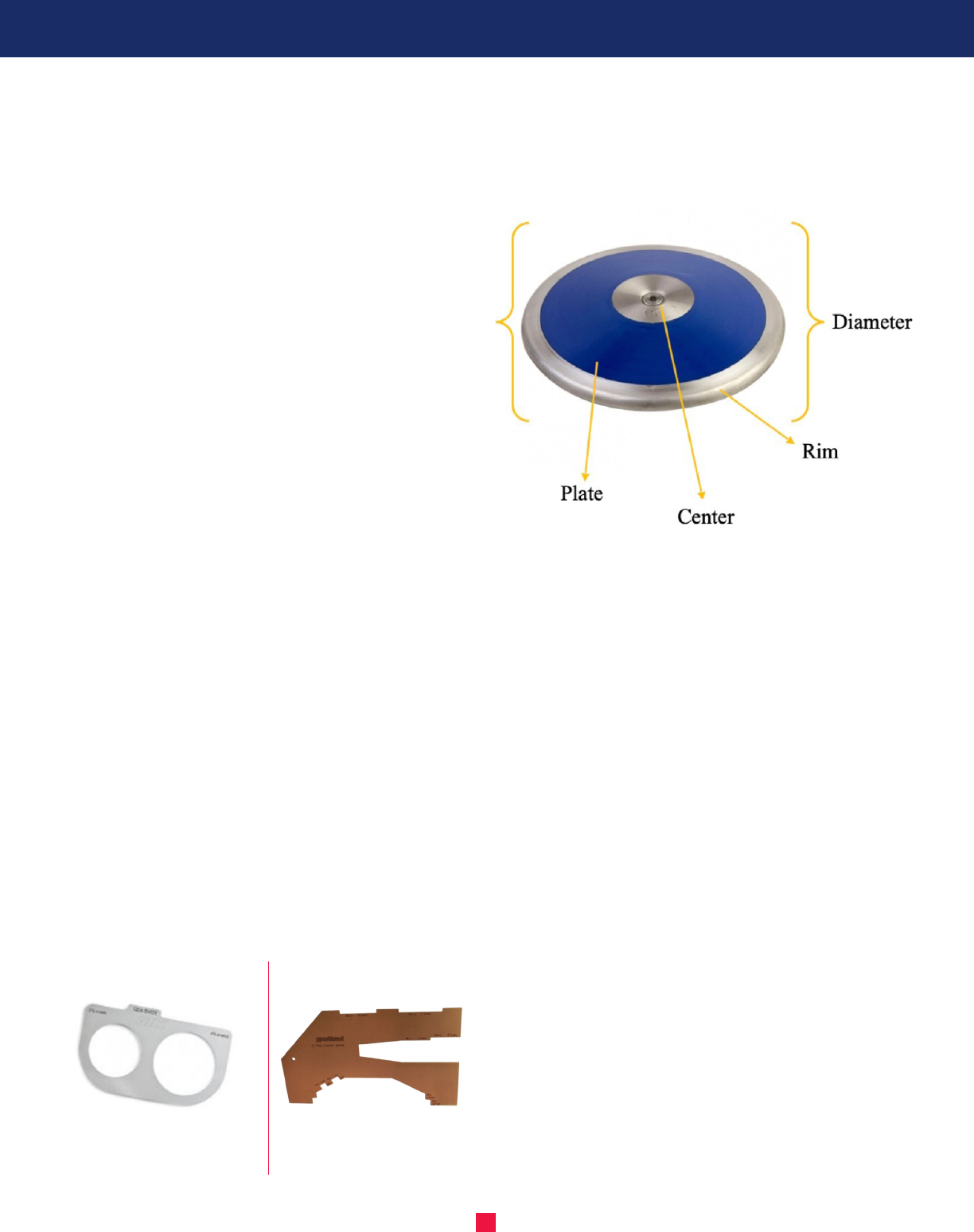
12
2023 PRE-MEET NOTES
Throws competition can be one of the more dangerous
events in track and eld if not properly ociated. The
purpose of inspecting implements is to be sure the use of
the implement does not cause an unfair advantage and is
safe for the athlete, competitors, ocials and spectators.
A damaged implement can result in injury to competitors,
ocials or spectators. In addition, an old, damaged or
otherwise altered implement can create an unfair advantage
to an athlete by allowing a better grip or ight of the
implement.
To properly inspect throws implements, two issues must be
addressed; weighing/measuring and inspection.
WEIGHING/MEASURING
To ensure the proper weight/measurement per NFHS Rules,
a calibrated scale and measuring device must be available.
Implements must be free of all tape, mud, or any other
objects attached.
Shot Put
1. The minimum weight of the shot is 12 lbs (5.443kg) for
Boys and 8.818 lbs (4.0kg) for Girls.
2. For Boys, the minimum diameter shall be no less than
3.873 inches (98.4mm), while maximum diameter shall
not exceed 4.625 inches (117.5mm).
3. For Girls, the minimum diameter shall be no less than
3.740 inches (95mm), while maximum diameter shall
be no more than 4.331 inches (110mm).
Fairness considerations must include checking minimum
weight, and minimum and maximum circumference. There
are several easy to use gauges on the market that allow quick
and easy measurement.
Figure 1 : Shot Put Gauge Figure 2 : Discus Gauge
Figure 3:
Discus
1. The minimum weight of the discus is 3.527 lbs (1.6kg)
for Boys and 2.205 lbs (1.0kg) for Girls.
2. The diameter of the Boys discus must be at least 8.228
inches (209mm), but not more than 8.307 inches
(211mm).
3. The center core must be between 1.968 inches (50mm)
to 2.244 inches (57mm) in diameter and 1.575 inches
(40mm) to 1.654 inches (42mm) in thickness.
4. Finally, rim thickness (1/4 inch from edge) must be a
minimum of 0.472 inches (12mm) and a maximum of
0.512 inches (13mm).
5. The diameter of the Girls discus must be at least
7.087 inches (180mm), but not more than 7.165 inches
(182mm).
6. The center core must be between 1.968 inches (50mm)
to 2.244 inches (57mm) in diameter and 1.457 inches
(37mm) to 1.535 inches (39mm) in thickness.
7. Finally, rim thickness (1/4 inch from edge) must be a
minimum of 0.472 inches (12mm) and a maximum of
0.512 inches (13mm).
Some competitors like to bring a heavier weighted
implement for warmups. Considering weight only, this
would be legal. However, the implement has to meet the
other specications such as the diameter and circumference
(Shot Put), and diameter, diameter core, thickness, rim
thickness and radius of edge (Discus).
08
EFFECTIVE IMPLEMENT INSPECTION
–
SHOT PUT & DISCUS
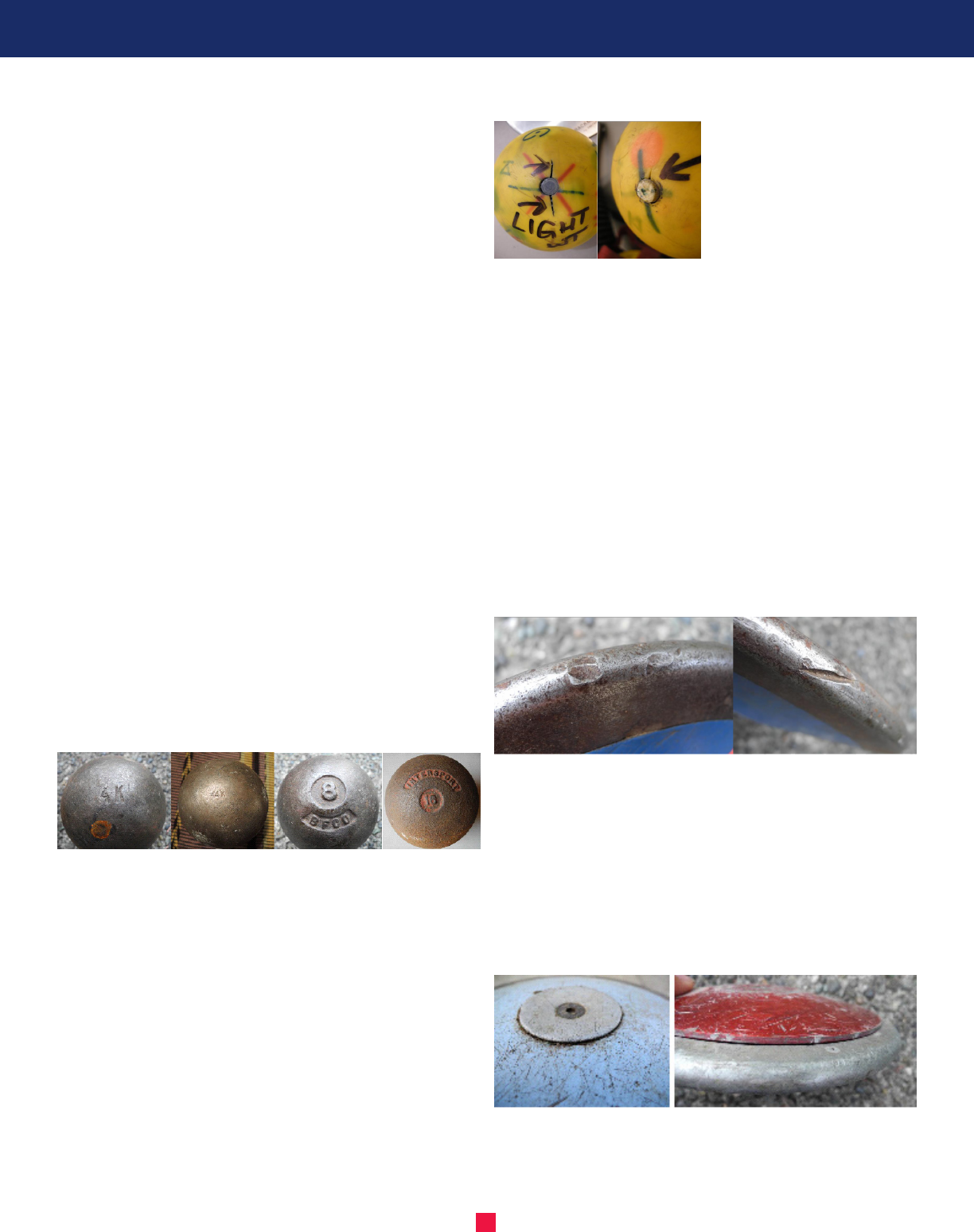
13
2023 PRE-MEET NOTES
INSPECTION
A towel should be available to hand to the competitor if the
implement is muddy or dirty. The athlete should have a clean
implement to hand to the inspector.
Minor blemishes are passable, however, anything that might
improve a grip would be considered unfair.
Shot Put
NFHS Rule 6.10.1 states that
1. The shot shall be constructed so its body is a solid
sphere made of any metal or suitable material not
softer than brass, or a shell of such metal lled with
lead or other material.
2. The shot shall not have indentations other than a
weight marking which must be manufactured in such a
manner that no advantage is gained by the grip.
3. For indoor meets only, a shot consisting of a shell of
rubber or plastic with a center lled with lead pellets
may be used.
Most shots today have their weight etched on the shot. This
would be considered acceptable as shown in Figures 4 and
5. However, there are some shots that have the manufacturer
name and weight as part of the mold. Some of these are
questionable such as Figures 6 and 7. These could be
disqualied based on the possibility of improving the grip.
Figure 4 Figure 5 Figure 6 Figure 7
Photos from USATF Best Practices Implement Inspectors Handbook
Indoor Shot:
The NFHS Rule 9.6.1 states - “For indoor meets only a shot
consisting of a shell of rubber or plastic with a center lled
with lead pellets may be used.” The maximum diameter for
the Boy’s Indoor Shot is 132.5 mm and the Girls Indoor Shot
is 130 mm to account for the synthetic cover.
Figures 8 and 9 show indoor shots that should be
impounded. The plug has caused cracking allowing the beads
to escape, resulting in the implement losing weight. Also,
when the plug is coming out as in Figure 9 it can be a danger
as well as allow for a possible change in grip.
Figure 8 and 9
Discus:
The NFHS Track and Field Rules Book allows the use of a
discus constructed entirely of rubber, plastic or metal, if it
conforms with the specications of weight, size and shape.
This is also the type of discus that may pick up illegal
blemishes the easiest.
Rule 6-10-3 gives these specications and states that the rim
shall not be sandblasted. It needs to be a smooth surface
devoid of marks that may give the athlete an advantage.
Prior to weighing the discus, the ocial should run their
hand around the rim. Figures 10 and 11 are candidates for
impounding the discus.
Figure 10 and 11
Photos from USATF Best Practices Implement Inspectors Handbook
The rim, body and center plates should be ush and t as
they were originally designed. These can be observed by
sight as well as feel. Figure 12 shows the center plate not
ush and Figure 13 shows the rim not tting. These would be
candidates for impounding.
Figure 12 and 13
Photos from USATF Best Practices Implement Inspectors Handbook
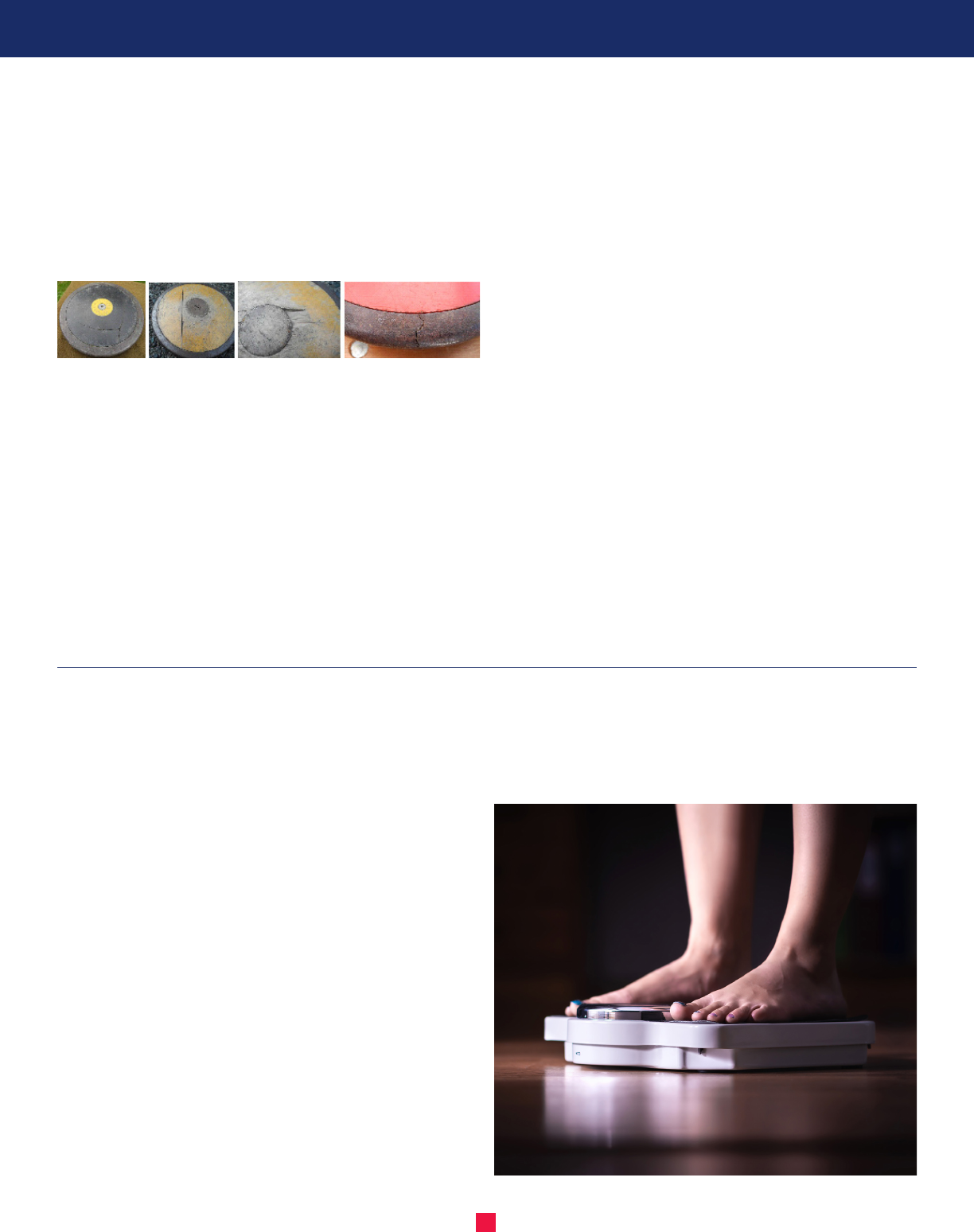
14
2023 PRE-MEET NOTES
Small dents are acceptable if they allow for all parts to t
properly and do not create an advantage for the athlete, such
as being able to increase the ability to grip the discus. Plates
and rims that are cracked should not be allowed as these may
turn into a safety concern. Figures 14-17 show some discus
that should not be allowed.
Figure 14-17
Photos from USATF Best Practices Implement Inspectors Handbook
What about a rattle in the discus? If in your opinion that
is due to a structural defect it is wise to look into it. A
structural problem is a safety issue. This type of discus
should be impounded.
Marking the Implements
The person inspecting implements must mark each
implement which has passed inspection and is legal with
a dened mark of the day. A paint pen is the best option for
creating such mark, though sharpies, nail polish, etc. may also
work. The most important factor is that the mark will stay on
the implement throughout the meet. All legal implements
should be clearly marked with the mark of the day. The exact
style of the mark is inconsequential, as long as it remains
consistent throughout the day and is placed in the same
general position on all implements.
The ocial/volunteer at the venue should be informed of
the color and the location of the mark of the day on the
implement and, as part of their instructions, ask the athlete
to show the mark prior to entering the ring or runway.
Impounding of Illegal Implements
NFHS Rule 3-2-4t grants the Games Committee the authority
to set up a procedure for impounding and releasing illegal
implements. This ensures that only legal implements are
utilized in warm-ups and competition. The impounded
implements should be marked with a dierent color and list
the school name so it may be returned to the correct school
at the conclusion of the event.
When inspecting implements, always err on the side of
caution. Be sure to think safety rst. If in doubt, impound.
09
BENEFITS OF WEIGHING POLE VAULTERS ON SITE PRIOR
TO COMPETITION
Vaulting poles, like the athletes who carry them, come in
many dierent lengths and weights. Matching the weight,
strength, and speed of the athlete to the weight rating of the
pole allows the athlete to be both successful and safe. An
athlete who is too heavy, or too fast or too strong, is more
likely to over bend and break the pole resulting in injury to
the athlete, a coach, ocial or other competitor from the
ying debris.
The NFHS rules state that no athlete may use a pole rated
for less than the weight of the athlete (Rule 6-8-15). Simple,
direct, and concise. Each state high school association has
a process in place to ensure that the properly weighed pole
is utilized by each and every competitor.
Benets to weighing in pole vaulters on site the day of
competition.

15
2023 PRE-MEET NOTES
1. Ensures that the competitor is properly utilizing the
correct weighted pole.
2. Provides safety to the competitor and the competition
area.
3. Assists in facilitating a fair and consistent competition
for all competitors.
Process
1. A certied scale must be on site for each competition.
2. Meet management must establish a weigh-in time on
meet information.
3. Each school must provide a designated ocial, coach,
AD, or administrator to supervise the weigh in.
What constitutes a certied scale? A portable bathroom
scale can do the job if you contact your local “Weights and
Measures” ocer at your city hall and ask them to test and
place a sticker (like the ones on a gas pump) on the scale.
Most won’t charge anything when you tell them it is for the
local high school.
At present, the NFHS Rules Book dose not permit the use
of variable weight poles, poles improperly marked, or a pole
rated below the competitor’s weight. Additionally, altering
the pole in any fashion renders it illegal. Penalty for these
infractions is disqualication from the event. Rule 6.8.15 states
that “Prior to competition, the coach must verify that all of
the school’s pole vaulters and poles” meet the stated weight
ratings.
Benets do exist to weighing pole vaulters on site the day of
a competition. However, your state high school association
must provide guidance to make the process a reality and
have it fall within rule guidelines.
10
TRACK AND FIELD INJURY
SURVEILLANCE STUDY
As participation in high school track and eld continues
to increase in the United States, the number of sports
injuries may also increase. The NFHS Sports Medicine
Advisory Committee (SMAC) and the NFHS Sports Rules
Committees use data from the National High School
Sports-Related Injury Surveillance Study (High School RIO
TM
)
to monitor rates and patterns of sports injuries among high
school athletes. High School RIO is currently collecting the
17th year of sports exposure and injury data.
Among the 20 sports currently under surveillance in High
School RIO, the overall injury rate in boys’ track and eld
ranked 15th
during the 2020/21 academic year, and the overall
girls’ track and eld injury rate ranked 12th (note, these results
may have been aected by COVID-19). The most commonly
injured body part in both boys’ and girls’ track and eld was
the hip/thigh/upper leg (boys: 55%, girls: 37%). The most
common injury diagnosis sustained during competition for
both boys’ and girls’ track and eld was strain (boys’: 73%,
girls’: 46%). Strains were also the most common injury
diagnosis sustained during practice (boys: 43%, girls: 33%).
Injury mechanisms were similar between boys’ and girls’ track
and eld with acute no contact as the most common
competition-related injury mechanism (boys’: 50%, girls’:
57%) and overuse/chronic as the most common practice-
related injury mechanism (boys’: 50%, girls’: 52%). In boys’
track and eld, 67% of subluxations/dislocations were
recurrent while 50% of subluxations/dislocations were
recurrent in girls’ track and eld.
The coronavirus pandemic remains a challenge for high
school sports due to extended absences and altered training
schedules. Understanding patterns of injury in track and eld,
both in general and related to the ongoing pandemic, is one
important tool when considering injury prevention eorts to
keep track and eld athletes as safe as possible.
If you are interested in more information about the High
School RIO Study or you are a certied athletic trainer who
is interested in becoming a reporter for track and eld,
please email the High School RIO team at highschoolrio@
datalyscenter.org. Please visit https://www.datalyscenter.org/
rio-annual-reports/ to access the annual summary report
referenced above.

16
2023 PRE-MEET NOTES
NEW to the 2023 NFHS Track and Field Rules Book is a rule
providing direct guidance in the administration of rerunning
races. The meet referee has the sole authority to determine if
a race shall be rerun, who is eligible to participate in a rerun,
and when it should be scheduled (Rule 3-4-3).
While the need to rerun a race is rare, it does happen. As it
will rarely, if ever, be fair to everyone, it should be avoided if
at all possible. To consider a rerun, one of the following must
apply:
1. Interference by another competitor; or
2. Interference caused by a non-participant; or
3. A meet administration error such as using the wrong
stagger(s), hurdle heights or spacing, ocial’s
instructions, etc.
Reruns should be considered only in races or relays in which
the distance run is 400 meters or less.
To determine who is eligible to participate in a rerun, the
hardship placed on the competitors running an extra race
and the fact that those who participate will have their places
and times from the original race replaced, must be weighed
against establishing an opportunity for a fair outcome.
Example #1
All runners in an intermediate hurdle race ran with the hurdles
improperly spaced.
The race should be reran after an appropriate rest period
for ALL participating runners.
Example #2
During an intermediate hurdle race, Runner A falls and knocks
a hurdle into Runner B’s lane causing interference.
RunnerAshallbedisqualied,andRunnerBiseligiblefor
a rerun. While other runners were not interfered with, they
also may be eligible for the rerun.
1. If some competitors were closely competing with
Runner B at the time of the infraction, and it is
determined that those nishing places were uncertain,
then those runners should be included in the rerun.
2. Runners whose places were clearly NOT aected by
the interference, because they nished well ahead or
well behind Runner B, should NOT be included in the
rerun.
11
GUIDANCE FOR THE ADMINISTRATION OF RERUNNING RACES
Photo provided by XL Sports Photography, New Mexico.

17
2023 PRE-MEET NOTES
3. A competitor who is eligible and elects to participate
in the rerun wipes out any performance, including
place, time or record, from the original race.
4. Any disqualication from the original race would stand.
Example #3
In the 4x200m relay, Team A was placed at the wrong
exchange zone during one of the handos. This is determined
after the race.
Team A must rerun the race and may compete with anyone
listed on the relay entry card.
Any disqualications from the original race would remain
in eect and make those competitors ineligible for the rerun,
unless it is determined that a meet administrative error
contributed to the disqualication. Such errors might include:
1. Starting at the incorrect line
2. Being given the wrong exchange zone
3. Other ocial instructions
The nal consideration in determining when a race is to
be rerun is to provide a sucient recovery period for the
competitors. This rest period must be provided to ensure the
safety of the competitors. Races should be rerun as soon as a
rest period can be provided, to maintain the ow of the meet
and in consideration of athletes who are still scheduled to
participate in other events. The referee should work closely
with meet management and the clerk of the course to decide
the time for the rerun. The referee may consult with coaches
of aected athletes to determine a time that allows their ath-
letes to recover but limits the impact on the rest of the meet.
Note: Although coaches may be consulted, it is the referee who
hasthenalauthoritytodeterminethetimeandparticipating
competitors of any rerun.
12 MIXED RELAYS AT TRACK &
FIELD MEETS
Mixed relays are becoming increasingly popular at high
school meets. A mixed relay typically consists of relay teams
comprised of two male and two female athletes.
The 2023 NFHS Track and Field Rules Book has added them
to special events (Rule 7-2-1f). Additionally, the rule provides
guidance indicating that mixed relays shall be conducted
under USATF event rules, unless state association policy
determines otherwise .
The mixed relay was introduced at the 2017 IAAF World
Relays and were then held at the 2019 World Athletics
Championships in Qatar. They have now become a xture
at World Athletics Championships and in 2023 are now also
allowed at high school meets.
The most popular mixed relay is the 4x400m where each
member of the team will run a lap around the track, passing
a baton to their teammate at the end of their lap. The race
provides diversity and a new level of strategy as it is down to
the individual team to decide which order they choose to run
in. The teams could choose both male athletes rst and then
the two females, or vice versa, or decide to alternate between
male and female runners.
If meet administration is going to include a mixed relay event
in their upcoming meet, communication is the key part in
making the mixed relay event a success. The following
information needs to be communicated to all invited schools
well in advance of the meet:
1. Mixed relays being contested (4x100m, 4x200m,
4x400m, 4x800m). On some school teams the female
and male teams have dierent coaches, so advanced
planning, discussion and cooperation are necessary.
2. Order of events where the mixed relays will be
contested in the order of events. A suggestion
would be to contest the relay after the completion
of the gender specic event of the same distance. For
example, a mixed 4x100m relay would occur after the
Female and Male 4X100m relays.
3. Will the mixed relays be included in the team scores?
This may aect placement of athletes in events
throughout the entire meet. If the event counts toward
team scores there are several possible scoring options:
• each place could be split and half given to each
gender’s team; or
• each gender’s team could receive total points for
each place.
4. Participation in a mixed relay would count as one of
the allowable 4 events no matter if the event counts
towards the team score or not.
Administration of the actual mixed relay race is the same as
normal single gender relay races of the same length, except
the mixed relay races are run by two female and two male
competitors.
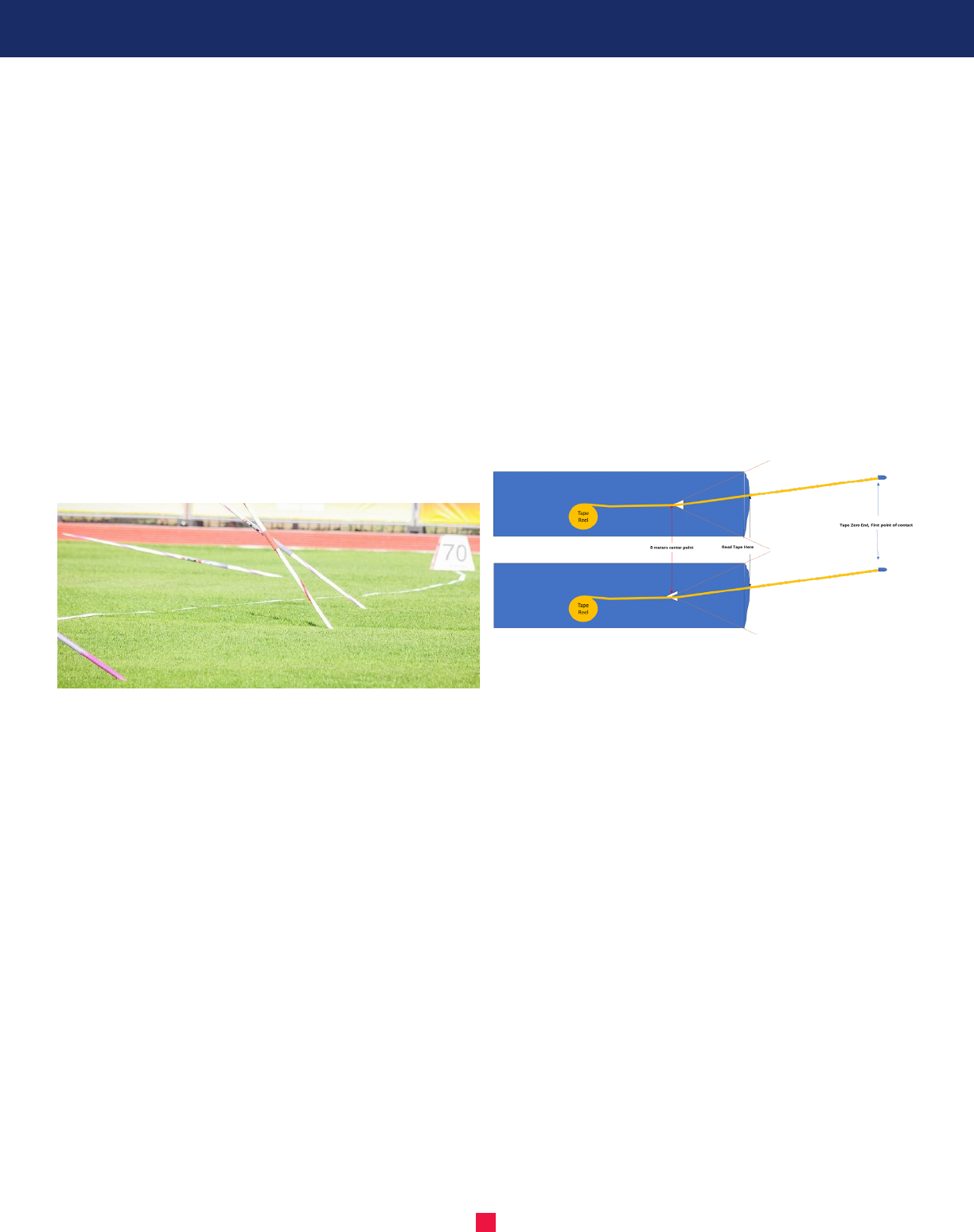
18
2023 PRE-MEET NOTES
At a track & eld meet, no throwing event measurement
presents as much of a challenge as the javelin. The challenge
centers around the varied landing options of the implement.
Per NFHS Rule 6-6-7:
“The measurements shall be from the nearest edge of the
rstpointofcontactmadebythejavelin”.
Identifying The First Point of Contact
There are ve potential options for the landing:
1. Tip rst – impact causes tip to stick in the ground
2. Tip rst – does not stick in ground- javelin slides
3. Tail rst – javelin bounces
4. Flat throw – neither tip or tail lands rst
5. Lands outside the sector
Point of measurement for each landing
listed above:
1. The rst point of contact will be the back end of the
sticking tip where the javelin made the rst contact
with the ground before it pierced further into the
ground.
2. Observe carefully where any part of the tip rst landed.
Do not get distracted by the slide of the javelin.
3. Observe where the tail rst landed. Do not get
distracted by the bounce of the javelin.
4. Assume the rst point of contact was the cord grip.
Observe carefully where the grip landed rst. The rst
point of contact would be from the back of the cord
grip (end nearest to the foul line).
5. It is a foul. The throw is not measured but counts as a
trial.
If the javelin lands with the rst point of contact but slides out
of the sector or sticks in the ground within the sector with
part of the body outside the sector, it is not a foul. First point
of contact is what matters.
Identifying the Center Point
The center point is located in the center of the runway,
26 feet, 3 inches (8 meters) behind the arc. All throws should
be measured along the line from this center point to the
landing point of the javelin. Javelin runways have a center
point marked in various ways. All are equally eective.
1. A dot or circle.
2. A triangle (topgure). The Red Dot indicates the center
point.
3. A “V” (bottomgure). The Red Dot (insidethe“V”)
indicates the center point.
Measuring The Throw
All measurements should be made with non-stretchable
tape such as berglass, nylon, steel, or a certied scientic
measurement device (laser), NFHS Rule 6-6-8.
1. Zero end of the tape should be held at the rst point
of contact made by the javelin.
2. The tape should be pulled to the point on the inside
edge of the circumference of the arc nearest such
contact and in line with the center of the circle
(illustrated in the gures above)
3. The measurements shall be from the inside edge
of the foul line arc.
4. Measurement is recorded to the inch or centimeter.
The measurement of the javelin relies on observing each
throw carefully to determine the rst point of contact and
measuring correctly to ensure a fair, consistent, and equitable
competition.
13
CORRECTLY MEASURING JAVELIN THROWS

19
2023 PRE-MEET NOTES
The tone of a high school track & eld meet is determined
by the fair and consistent starts administered by the starters.
Throughout the varied race distances, the presentation of
the starting commands must remain consistent to facilitate
fair and equitable competition. This tone is set in pre-meet
discussions with start area personnel and at the start of each
race.
Starting Commands outlined in NFHS Rule
5-7-2:
1. The starting commands for races or opening relay
legs of less than 800 meters outdoors and 600 meters
indoors shall be: “On your marks.”
2. At this signal, the competitors will immediately take
their proper positions behind their starting lines.
3. After they have taken their positions and are steady
on their marks, the starter shall instruct them, “Set.”
4. At this command, all competitors shall at once, and
without delay, assume their full and nal set position
in such a manner that no part of their person touches
on or over the starting line.
5. When all competitors are set and motionless, the
starter shall re the starting device.
New in 2023:
6. Theintervalbetweenthesetcommandandthering
of the starting device is approximately two seconds.
7. Afterastartergivestheorder“Set”,ifanycompetitoris
inmotion,thestartershallnotrethestartingdevice.
Note: The inclusion of the NEW #6 above, provides each
competitortheopportunitytosettleintotheirnalsetposition
andbecomemotionlesspriortotheringofthestartingdevice.
Pre-Meet
Starters should meet with meet personnel assigned to the
start line area to dene their role in the starting procedures.
1. Having clerks give prior-race instructions to the
competitors before they approach the start line should
be considered. Instructions will be given by the starters
if there are no clerk(s) available.
2. Clerks shall inform the competitors that once placed
at their designated start line(s), they will give their
attention to, and react promptly to the commands of
the starters, and shall remain motionless until the ring
of the starting device.
Race Time
1. The starter and assistant starter(s) shall be in a position
so that all competitors hear the commands. Best
Practice positions are available in the 2023-2024
NFHS Ocials Manual under Additional Forms.
2. Proper start commands shall be verbalized in a rm,
calm, and projected voice. Volume and tone shall
be consistent from the beginning to the nal set
command.
3. The “Set” command should be a normal spoken
command.
4. If there is any unsteadiness or unreadiness of any
competitor, prior to the ring device, the starter or
assistant starter(s) shall instruct the competitors to
“Stand Up”. This ensures fairness to all competitors.
5. The starter and assistant starter(s) shall discuss any
issues and inform the competitors of the appropriate
decision, before restarting the race.
6. The starter and assistant starter(s) shall implement
these same principles for each race. This ensures
consistency for all competitors.
When working as a Start Team with one or more assistant
starters, communication between all is of utmost importance.
All members of the Start Team must provide identical
consistency and fairness to the start of each race.
There are many factors which attempt to create variance
in the starting commands and procedures. The starter and
assistant starter(s) must adapt and react to the moment, but
yet remain true to the established start policies, procedures,
and delivery.
Creating and maintaining fair and constant starts will ensure
that each competitor is aorded the opportunity to compete
to their fullest potential and provides a framework for
equitable competition.
14
FAIR & CONSISTENT STARTS
Photo provided by Minnesota State High School League.

20
2023 PRE-MEET NOTES
The issue with the dwindling number of ocials can
be broken into two areas – recruitment and reten-
tion. While the issue of recruitment is an absolute
necessity, we cannot forget the importance of keep-
ing ocials in once we have them in our ranks. Re-
tention is one of the most dicult aspects of main-
taining the ocials’ pipeline, as it is so multifaceted,
including training, evaluation, relationship building, treatment
of ocials, recognition of ocials and so much more.
One of the largest components of retaining our ocials,
however, is that of mentorship. While that is a great word and
is something that we talk about all the time, we must truly
understand what mentorship is, what a mentor is and how we
can facilitate and foster productive, meaningful relationships
between new ocials and veteran ocials in order to have a
plan that works for us.
So, let’s break it down. In the Merriam-Webster dictionary,
a mentor is dened as: a) a trusted counselor or guide or;
b) tutor or coach. Mentorship is then dened as the
inuence, guidance or direction given by a mentor. Sounds
easy enough, right? Well, in the words of Lee Corso, “Not so
fast…”
The problem with nding mentors within any population is
the basic fact that not everyone is cut out to be an eective
mentor. Just because someone has 30 years of experience
doing something does not mean that he or she has the ability
to mentor. A mentor needs to possess more than just
experience or knowledge. A mentor must be seless and
willing to put him or herself out there to make someone
else better than he or she is. This takes a great degree of
condence and a servant’s heart. This means that the mentor
has to believe in the greater good and has to have the desire
to leave their profession, avocation, organization or company
better than he/she found it.
I once heard the best perspective about mentoring from NFL
Referee Scott Novak. He dened the core principle of a
mentor in one brief sentence, “A mentor has to be willing to
trainanocialoragroupofocialstoonedaytakehisjob.”
As a mentor in ociating, you have to get over the fear that
someone is going to take your games. You have to
realize there are plenty of games to be had and you
have to approach mentorship as an honor. Good
mentors want their mentees to succeed at a level
higher than they did. It is kind of like parenting.
Parents want to see their kids to be more than they
were. Truly eective mentors operate in the same
way. When the mentee succeeds, they mentor has a sense
of pride instead of one of jealousy or envy or the thought
of, “Why not me?”
I read an article some time ago about the three C’s of
mentorship in terms of the roles that a mentor should play.
These roles are:
• Role #1 – Consultant – Mentors should be individuals
who inform their mentees about the policies and
practices of their state and local associations. They
should help mentees through the process of
registration, purchasing uniforms, navigating
governing documents and online platforms and
advising as to camps and clinics their mentees should
attend. A mentor should provide the what, why and
how of their thinking and should go beyond just
simple advice.
• Role #2 – Counselor – Mentors should be there to
listen and understand the concerns and frustrations of
their mentees. Sometimes, a mentee is seeking advice
and other times, they just need a willing ear. Mentors
should be prepared for both circumstances.
• Role #3 – Cheerleader – While a mentor should
provide a fair amount of advice and constructive
criticism, one of the most important roles a mentor
serves is that of an enthusiastic supporter, one who is
the rst to congratulate a mentee on a job well done
and who celebrates successes and lifts the mentee up
during the hard times.
If you are a new ocial and you do not yet have a mentor, we
encourage you to seek one out, if your local association does
not have a formalized mentorship program. Find someone
you connect with, someone who has a similar background
or interests as you and, most importantly, someone you can
trust. If you start a mentor/mentee relationship with someone
15
MENTORSHIP AS AN OFFICIATING RETENTION STRATEGY
–
DANA M. PAPPAS, NFHS DIRECTOR OF OFFICIATING SERVICES
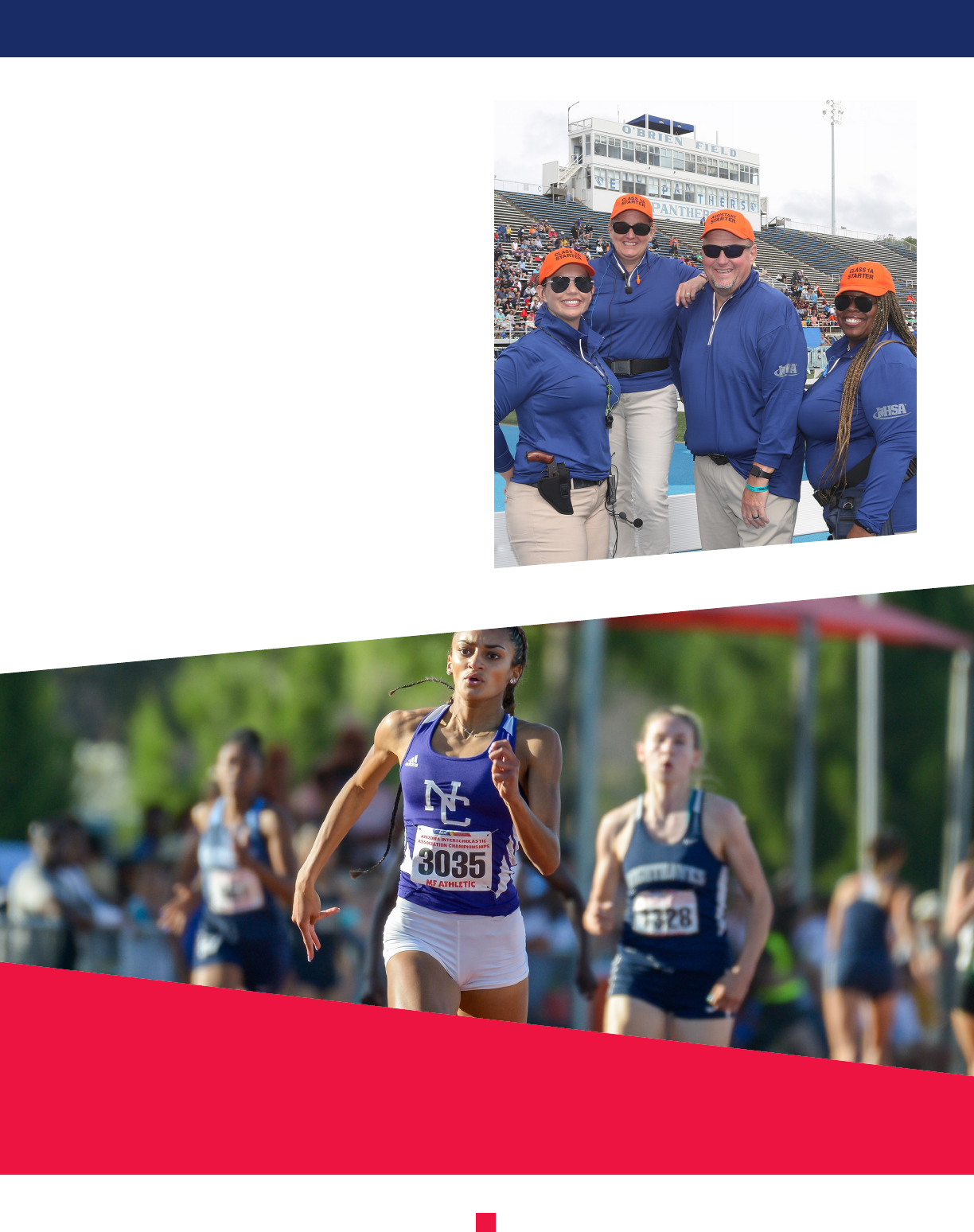
21
2023 PRE-MEET NOTES
and you nd that person is not helping you but is almost det-
rimental to the trajectory of your career, it is okay to termi-
nate that relationship. Ask your local level leadership or
our state oce to help you nd a mentor if you are
struggling to nd one. Keep in mind that the ocial with
the most experience may not be the best mentor. Keep in
mind that your mentor may actually be someone who is
younger than you in age but has experience and wisdom to
share with you. Find someone with whom you can truly have
a meaningful connection and who will help guide you rather
than attempt to derail you.
American entrepreneur, Jim Rohn, once said, “My mentor said,
‘Let’s go do it,’ not “You go do it.’ How powerful when someone
says,‘Let’s!’” To the mentors within ociating associations
throughout the country – be there with and for your mentor
and help them succeed WITH you. To those being mentored
– make sure your mentor is someone who wants to be your
partner in this journey of ociating and who has your success
at the center of what he/she is telling you. These basic
principles will let you know if you are being an eective
mentor OR if you are being eectively mentored.
Photo provided by Paynter Pics, Arizona Interscholastic Association.
Photo provided by Visual Image Photography, Illinois.

22
2023 PRE-MEET NOTES
FAT (Fully Automatic Timing) has become a common nish
line system at many high school track & eld meets. From
Championships to invitationals and even interleague
competition, FAT is the preferred and most accurate provider
of track results.
At one time, FAT systems were hard wired and each element
was set and adjusted manually. The process was very
technical, as well as very expensive. FAT providers were
an elite group that reserved their services for national
championships, prestigious invitationals, and collegiate
competitions.
New technology has simplied a FAT systems. Laptops have
become common place and the development of wireless
systems simplied the quantity of equipment needed. More
FAT companies have been established allowing greater
availability and more competitive pricing. Some school
systems have even made the investment to purchase their
own FAT system for their track & eld and swimming
programs. Coaches are certainly appreciative when attending
a meet where their services at the nish line are not required
for timing.
When hosting a meet where FAT system is to be hired, the
meet director becomes the primary communique with the
FAT provider. The success of the meet depends on a cohesive
relationship between the two. Meet directors should keep
in mind that the FAT provider is hired by the host and is
working for the meet director. Before contacting a FAT
provider, the meet director should make a list of the services
desired from the provider. What is included in the pricing?
• Hip numbers
• Bib Numbers
• Live Results/Printed results for posting
• Entries
• Scratch Sheets
• Clerking/Field Sheets
• Scoring
It is wise to shop around, not only to nd the best price for
the services provided, but also for a provider that works well
with the meet director. Questions to ask potential FAT timing
provider:
• Are they available on the date needed?
• Are they accepting of adjustments in heats and entries
the day of the meet?
• Are they providing an electronic starting device or will
the starter be using a .32/.22 caliber pistol? (Which is
preferred by the meet director?)
• Do they have one or two certied ocials reading the
pictured results? (Rule 3 Section 8 Article 1)
• Are they accepting of reviewing the pictured results
by the referee or jury of appeals?
• What are their electricity needs?
• Will they be positioned on the inside or the outside
of the track?
• What are their venue requirements? (Is a tent needed
and who supplies it?)
When setting the structure for the meet, information must be
given to the FAT provider so the meet format will be to the
host’s desire. The meet director or the games committee sets
the number of athletes allowable in non-laned races and the
number of events in which an athlete may participate. Rule
4-2 sets participation limits for athletes. If the entry limitations
are more restrictive, the FAT provider will need to be
informed (Rule 3-3-3). The FAT provider will also need to
know the number of athletes that advance to nals, as well as
how an athlete progresses through the rounds. It cannot be
assumed that the FAT provider will setup the meet in the way
that is acceptable to the host. The more information that can
be given on the particulars of the meet, the better o the host
will be with the format utilized by the FAT provider. The FAT
provider may also have suggestions based on their expe-
rience that could help with the ow of the meet. Pre-meet
discussions are essential.
Upon entering a meet, the meet director should feel
condent that the FAT provider will run the meet the way
the host intends. As mentioned previously, the FAT provider
is employed by the meet director/host school and should be
exible and accepting to the meet’s needs. When the meet
director and the FAT Provider are on the same page, major
details concerning the meet will not be a frustration to
either party.
16
THE MEET DIRECTOR/FAT PROVIDER RELATIONSHIP

23
2023 PRE-MEET NOTES
The NFHS Coaches Association’s mission
is to enhance the professional devel-
opment of all high school coaches
to improve interscholastic athletics.
NFHSLearn provides opportunities for
coaches to learn and gain knowledge
on NCAA eligibility, proper nutrition for
athletes to perform at their best, and
provides coaches with information on
how to hone their skills to teach their
respective sports/activities. A coach
can consistently use the platform to
maintain credentials to coach the sports
they are most passionate about. The
courses oer valuable insight on how to
assist athletes to build character through
competing, and the resources are easy
to navigate and benecial in maintaining
a successful program.
Assistant coaches are also encouraged
to navigate NFHSLearn to identify the
courses they need, not only for
eligibility to coach, but to identify
resources that can be utilized to add
to their knowledge and skills. Heat
acclimatization, concussion protocols,
First Aid and how to administer CPR
provided by NFHSLearn helps to keep
athletes safe from potentially hazardous
environmental factors that place them
at risk for serious health issues. Valuing
these protocols allows a coach to focus
on placing the athletes’ health above
competition.
It is important for a coach to provide
an experience where the players can
ourish and develop as student
athletes, while feeling safe and support-
ed. NFHSLearn oers courses and
information for all stakeholders to
ensure young people are protected and
can focus on excelling through sports.
There are resources for ocials to learn
and understand the rules for fair and
equitable play. Ocials can also learn
to identify how to protect athletes from
bullying, hazing, and inappropriate
behavior while competing. There are
courses for parents to help support their
children with the many stressors that
can come with sports/activities and help
maintain a strong academic standing.
Most importantly, students can
interact with NFHSLearn to gain the
skills needed to navigate through high
school competition, prepare for the
next level of competition, and gain an
understanding of what the body needs
to perform at a high level through
nutrition courses.
NFHSLearn is the ultimate guide
for high school coaching as it allows
coaches and other stakeholders to
become familiar with what is needed
to build strong, supportive, and safe
programs. NFHSLearn ensures that
coaches are well prepared with the skills
to coach and protect their players, while
oering an opportunity to learn about
rules, policies, safety, character build-
ing, and positive team outcomes. The
NFHSLearn site consistently updates
content as the world of high school
sports evolves and focuses on
preparing individuals who impact the
lives of young athletes to provide an
environment that supports health
and success. Those who seek to build
winning programs, develop athletes, or
simply want to nurture and support
children can pull from this platform to
be eective leaders within their team
and community. As an educator and
coach of high school-aged students,
incorporating NFHSLearn into the
curriculum can prepare scholars for
internships and careers such as sports
medicine and athletic training.The
certications available to students not
only enhance their knowledge putting
them a notch ahead of their peers, but
build condence and empower scholars
to be the standard of our future leaders.
Tia Clemmons, MSA Jackson-Reed High
School, Washington, DC.
17
AN HONEST PERSPECTIVE: THROUGH THE LENS OF
AN EDUCATOR AND COACH
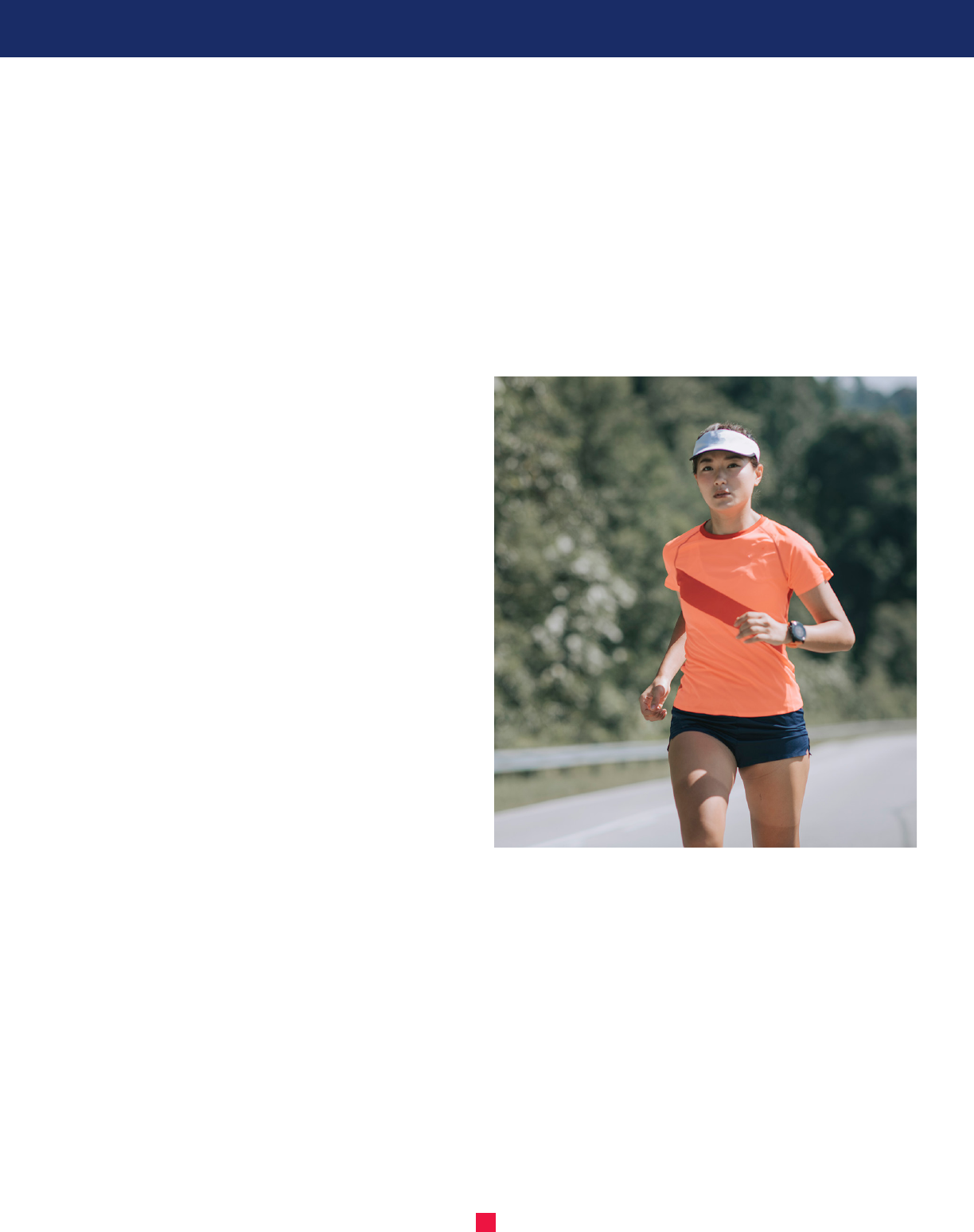
24
2023 PRE-MEET NOTES
It is not uncommon to see people of all ages along the side
of the road out for a run. There are almost 500,000 cross
country athletes and more than one million track and eld
athletes at the high school level. These numbers do not
include the thousands of athletes who run during training for
other sports and Special Olympics track and eld athletes.
Surveillance by the National Center for Catastrophic Sport
Injury Research (NCCSIR) reported seven running-related
motor vehicle crashes between 2011 and 2020, resulting in
eight deaths, two disabling injuries among middle school
and high school cross country and track and eld athletes.
In addition, a 45 percent increase in pedestrian deaths was
observed between 2009 and 2017 in the United States. In an
eort to promote roadside safety for high school runners, the
NCCSIR compiled the following pedestrian and runner safety
recommendations from national agencies and organizations
that are supported by previous research.
Runner Roadside Safety Recommendations:
• Use sidewalks when available or run facing trac.
• Stay alert and avoid wearing headphones and using
electronic devices, including cell phones.
• Cross roads at crosswalks and intersections, when
available. If not, cross at a well-lit location.
• Avoid running when it is dark. If it is dark, wear bright,
reective materials and/or use a ashlight or head lamp.
• Follow the rules of the road.
• Avoid running along eastbound roads at sunrise or along
westbound roads at sunset.
Additional Recommendations based on seven
running-related motor vehicle crash incidents
reported by NCCSIR:
• Provide a safety orientation for rst-year runners
• Run in pairs
• Never run against trac lights
• Avoid running in higher trac speed areas
• Run during lower trac times if running along a road
• Avoid loitering along the road before and after runs
Use sidewalks when available or run facing trac. Accord-
ing to the National Highway Trac Safety Administration’s Fa-
tality Analysis Reporting System (FARS), at least 91 percent of
pedestrian fatalities in 2017 occurred in areas other than side-
walks. Additionally, a study comparing the walking patterns
of fatally injured and non-fatally injured pedestrians struck by
motor vehicles found a 77 percent lower risk of motor vehicle
collision among pedestrians who walked facing trac.
Stay alert and avoid wearing headphones and using
electronic devices, including cell phones. A virtual pedes-
trian environment study found that participants distracted by
texting on cell phones and participants distracted by listen-
ing to music through headphones were more likely to be hit
by vehicles while attempting to cross streets in the virtual
environment than participants that crossed undistracted.
Additionally, participants distracted by electronic devices and
music were more likely to look away from the street than un-
distracted participants. This study suggests that the cognitive
demands of texting and reduced ability to pick up auditory
cues from vehicles while wearing headphones may contribute
to these results.
18
TIPS FOR SAFER RUNNING ALONG THE ROADSIDE

25
2023 PRE-MEET NOTES
Another study, comparing auditory perception in cyclists with
two earbuds, one earbud and no headphones, found that an
auditory stop signal that was heard in subjects with no head-
phones and one earbud, was not heard by many of the cy-
clists with two earbuds. Despite a small sample size of cyclists
with one earbud, this may suggest an alternative solution to
listen to music while running without risking safety.
Cross roads at crosswalks and intersections, when avail-
able. If not, cross at a well-lit location. According to the
National Highway Trac Safety Administration’s FARS, at least
73 percent of all pedestrian fatalities in 2017 occurred in loca-
tions other than intersections. One study, assessing pedestri-
an-injury severity in motor vehicle crashes, found a decreased
risk of fatal injury at trac signals. This, they suggest, may
be due to vehicles moving at slower speeds at intersections
when compared to speeds at midblock roads and better
“right of way” knowledge between motorists and pedestrians
at trac signals.
Avoid running when it is dark. If it is dark, wear bright,
reective materials and/or use a ashlight or head lamp.
The National Highway Trac Safety Administration identi-
ed 75 percent of 2017 pedestrian fatalities occurred in dark
lighting conditions. Studies have found that, in comparison to
daylight, dark lighting conditions increased the risk of motor
vehicle crashes involving pedestrians. This risk is heightened
during inclement weather. While any bright, reective clothing
may increase pedestrian visibility at night, one study identied
that reective material attached to the limbs of pedestrians,
including wrists, ankles, and major joints, increased driver’s
recognition distances of the pedestrians by 60-80 percent
compared to reective material surrounding the torso.
Although the denition of darkness diers between studies,
these studies tend to identify darkness as non-daylight hours,
including dusk and dawn.
Follow the rules of the road. A study of illegal pedestrian
road crossings set in Australia observed walking patterns
against signalized intersections. Illegal pedestrian road cross-
ings were dened as entering the intersection against the pe-
destrian trac signal (both blinking and steady) and crossing
the road away from, but within 20 meters of, the intersection.
It was determined that pedestrians who crossed illegally at or
near an intersection were at a risk of motor vehicle collision
around eight times greater than pedestrians who crossed
legally.
Avoid running along eastbound roads at sunrise or along
westbound roads at sunset. An investigation of crashes in
relationship to high sun glare times found that, when com-
pared to expected crash values, crashes were more prevalent
during sunrise on eastbound roads and during sunset on
westbound roads with sun glare. Additionally, higher trac
volumes during these times increased the crash risk further.
These ndings were more substantial in the early spring, fall,
and winter seasons.
References
1. Adapted by permission from BMJ Publishing Group Limited. Naumann
RB, Kuhlberg J, Sandt L, et al. Integrating complex systems science
into road safety research and practice, Part 2: applying systems tools
to the problem of increasing pedestrian death rates. Injury Prevention
2020;26:424-431.
2. National Federation of State High School Associations. (2019, Aug.
28). 2018-19 High School Athletics Participation Survey. Retrieved from
https://www.nfhs.org/media/1020412/2018-19_participation_survey.pdf.
3. Pedestrian Safety. National Highway Trac Safety Administration website.
Accessed September 15, 2020. https://www.nhtsa.gov/road-safety/
pedestrian-safety.
4. RRCA General Running Safety Tips. Road Runners Club of America
website. Accessed September 15, 2020. https://www.rrca.org/education/
rrca-general-running-safety-tips.
5. Pedestrian Safety. Centers for Disease Control and Prevention website.
Accessed September 15, 2020. https://www.cdc.gov/motorvehiclesafety/
pedestrian_safety/index.html.
6. Tator, CH. Bicycling and Other Street Activities. In: Tator, CH. Catastrophic
Injuries in Sports and Recreation. University of Toronto Press; 2008:369-
416.
7. Pedestrian Safety Tips. Safe Kids Worldwide website. Accessed October
6, 2020. https://www.safekids. org/tip/pedestrian-safety-tips.
8. Trac Safety Facts. National Highway Trac Safety Administration.
https://crashstats.nhtsa.dot. gov/Api/Public/ViewPublication/812681.
Published March 2019. Accessed September 17, 2020.
9. Luoma J, Peltola H. Does facing trac improve pedestrian safety?
Accident Analysis & Prevention 2013;50:1207- 1210.
10. Schwebel DC, Stavrinos D, Byington KW, et al. Distraction and pedestrian
safety: How talking on the phone, texting, and listening to music impact
crossing the street. Accident Analysis & Prevention 2012;45:266-271.
11. Waard DD, Edlinger K, Brookhuis K. Eects of listening to music, and
of using a handheld and handsfree telephone on cycling behaviour.
Transportation Research Part F: Trac Psychology and Behaviour
2011;14(6):626-637.
12. Kim JK, Ulfarsson GF, Shankar VN, Mannering FL. A note on modeling
pedestrian-injury severity in motor-vehicle crashes with the mixed logit
model. Accident Analysis & Prevention 2010;42(6):1751-1758.
13. Kemnitzer C, Pope CN, Nwosu A, et al. An investigation of driver,
pedestrian, and environmental characteristics and resulting pedestrian
injury. Trac Injury Prevention 2019;20(5):510-514.
14. Uttley J, Fotios S. The eect of ambient light conditions on road trac
collisions involving pedestrians on pedestrian crossings. Accident
Analysis & Prevention 2017;108:189-200.
15. Luoma J, Schumann J, Traube E. Eects of retroreector positioning on
nighttime recognition of pedestrians. Accident Analysis & Prevention
1996;28(3):377-383.
16. King MJ, Soole D, Ghafourian A. Illegal pedestrian crossing at signalised
intersections: Incidence and relative risk. Accident Analysis & Prevention
2009;41(3):485-490.
17. Mitra S. Sun glare and road safety: An empirical investigation of
intersection crashes. Safety Science 70 2014;246-254.
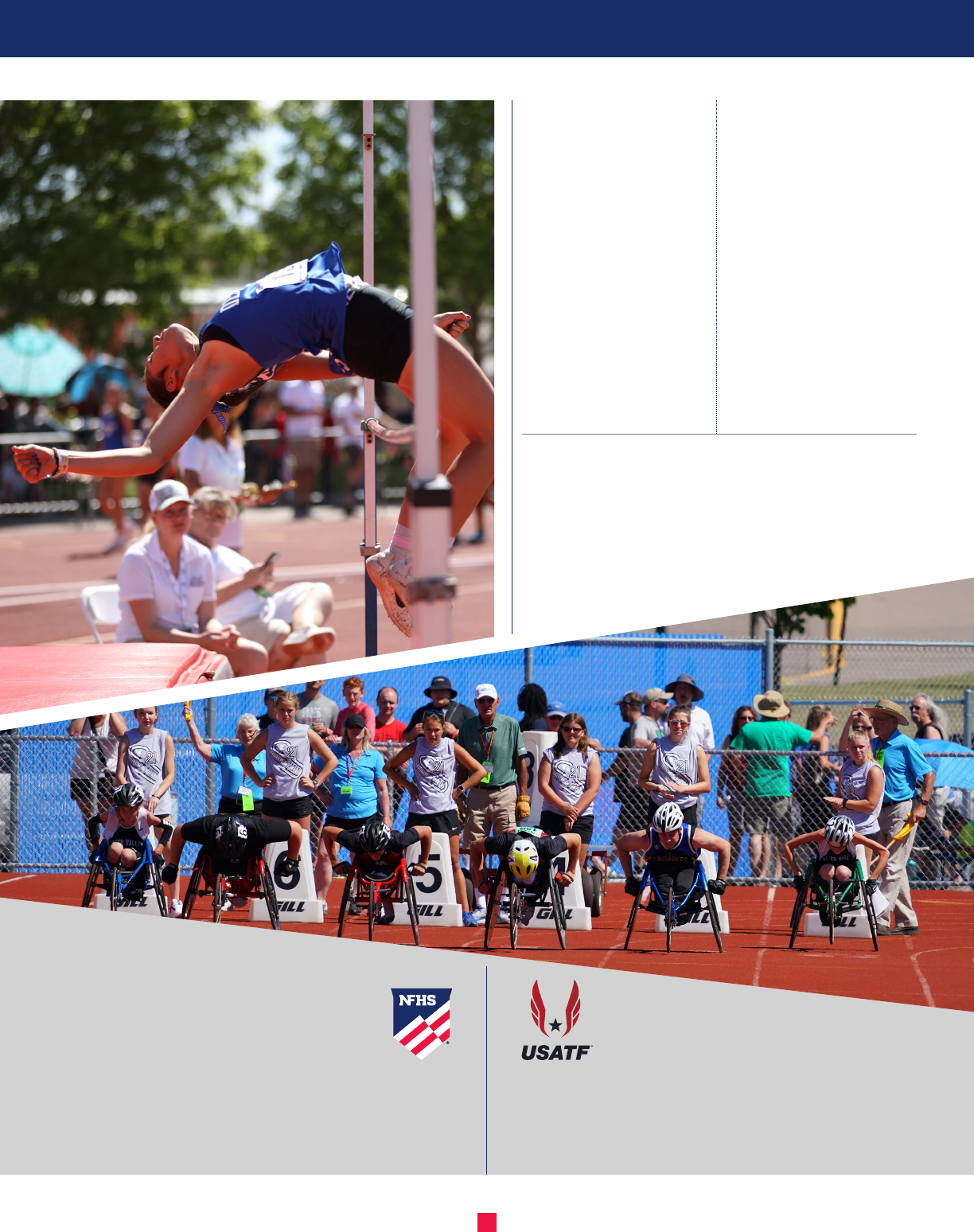
26
2023 PRE-MEET NOTES
USA Track and Field
132 E. Washington St., Suite 800, Indianapolis, IN 46204
Phone: 317-261-0500
National Federation of State
High School Associations
PO Box 690, Indianapolis, IN 46206
Phone: 317-972-6900 | www.nfhs.org
© 2023 by NFHS and USATF Ocials Training Subcommittee. All rights reserved. Permission is
granted to copy and use in its entirety by an individual or nonprot organization solely for the
purpose of training track and eld ocials. Any other use, or use of any portions of this document,
is prohibited without written permission from the NFHS and USATF Ocials Training Subcom-
mittee. Edited and written by Julie Cochran, NFHS Track and Field Rules Editor, Robert Kern, US-
ATF Ocials Training Committee and Mark Heckel Chair for Training, USATF Ocials Committee.
Acknowledgments to authors and editors who contributed to the 2022 NFHS Track and Field
Pre-Meet.
Contributors:
Boyd, Richard (Auburn, IN)
Brand, Connie (Shawnee, KS)
Bruening, Lisa (Waukesha, WI)
Clemmons, Tia (Upper Marlboro, MD)
Collier, Kyle (Pottsboro, TX)
DeYoung, Mary (De Pere, WI)
Egan, Dan (Madison, WI)
Fergus, David (Elk River, MN)
Freeman, Yolanda (Columbus, OH)
Gidari, Robert (Gostown, NH)
Griggs, Carolyn (Philadelphia, PA)
Grimes, Yvonne (Sandy Hook, CT)
Heckel, Mark (Hughesville, PA)
Hegge, Jon (Evansville, WI)
Kessler, Steven (Vernon Hills, IL)
Lohr, Carter (Winchester, KY)
Louis, Gloria (Lafayette, LA)
Merrill, Matt (Hilton, NY)
Meyer, Dennis (Waukesha, WI)
Nickels, Dave (Manitowoc, WI)
Padgaonkar, Ajay (San Jose, CA)
Pretty, Patrick (Cedarburg, WI)
Reed, Betsy (Henderson, NV)
Ronan, Patrick (West Newberry, MA)
Rouse, Patty (Elizabethtown, KY)
Sales, John (Altamonte Springs, FL)
Springer, Bob (Seattle, WA)
Sudrla, Terry (Sioux, IA)
Weir, Douglas (Paw Paw, MI)
White, Annette (Philadelphia, PA)
Williams, Rhiny (Artesia, NM)
Woolley, Dan (Hendon, VA)
Graphic Designers:
Kim Vogel, NFHS
Photos provided by XL Sports Photography, New Mexico. Below: Minnesota State High
School League.
